






















tennis returned to the World’s Most Famous Arena as Carlos Alcaraz, Emma Navarro, Jessica Pegula and Ben Shelton put on a show for the sold-out Madison Square Garden crowd in two separate singles matches at The Garden Cup in December.
“Brings back so many good memories, so many emotions,” said U.S. Open finalist Pegula upon returning to NYC. “I can’t believe we’re here at the Garden playing tennis. It’s so cool.”

The night began with a match between two juniors, twin sisters Annika and Kristina Penickova, two of the topranked juniors on the ITF Junior Tour, which was the appetizer to the two featured singles matches that would follow.
First, two New York-born women ranked inside the Top 10, Navarro and Pegula, squared off, as they returned to the city where just three months prior each had compiled their best results ever at a major.
At the U.S. Open, Navarro reached the semifinals while Pegula reached the final, but on this night, it was Navarro who got the better of her compatriot. Navarro outplayed Pegula in a first-set tiebreaker, and fought back in the

second set to win the match in straight sets 7-6, 7-5.
“Just so special to be here playing in this arena,” said Navarro. “It’s insane. We came to the Knicks game last night, [and] now they have a tennis court.”
Following the ladies on center court was the marquee matchup between young American Ben Shelton and Spanish star Carlos Alcaraz, two of the most entertaining players in the game today.
And the two did not disappoint.
Booming serves, drop shots and ridiculous rallies produced ‘oohs’ and ‘ahhs’ from the New York City crowd, as Alcaraz outlasted Shelton in the back-and-forth match 4-6, 6-2, [1-0].
At one point, Shelton handed his racquet to a fan to play a point with Alcaraz, and the fan hit a topspin forehand that landed just beyond the baseline.
“I’m trying to make the people enjoy watching tennis,” Alcaraz said in his postmatch interview.
“I hope the people enjoyed the match, and that’s what I try to do every time.”
The Garden Cup was the first time since the BNP Paribas Open in 2017 that professional tennis was played at Madison Square Garden, and the success of The Garden Cup was on full display, and the team behind the event is already excited to build on it in 2025.
“The Garden Cup exceeded all expectations with a sellout crowd of 19,698 creating an unforgettable atmosphere,” said Adam Thier, the former Vice President at MSG Sports who now works as a sports event promoter, and who played a vital role in bringing pro tennis back to the Garden. “For two days, the players lit up New York City with their smiles— whether at press events, clinics, sponsor parties, or putting on an incredible show on the court. Alcaraz and Shelton played one of the most entertaining tennis exhibitions I've ever seen. The atmosphere in the arena was electric. We are already planning “Tennis Night Out” for 2025 and have some exciting announcements to come soon.”
New York
1228 Wantagh Avenue, Suite 203 Wantagh, NY 11793-2202
Phone: (516) 409-4444 • Fax: (516) 409-4600 Web site: www.nytennismag.com
Staff
David Sickmen Publisher (516) 409-4444, ext. 309 david@usptennis.com
Brian Coleman
Senior Editor (516) 409-4444, ext. 326 brianc@usptennis.com
Joey Arendt Art Director
Marie Santora-Lent
Advertising Coordinator (516) 409-4444, ext. 301 Marie@usptennis.com
Emilie Katz Assistant Marketing Coordinator
Dr. Tom Ferraro Contributing Writer
Rob Polishook Contributing Writer

1The Garden Cup Electrifies New York City With First Professional Tennis Event at MSG Since 2017
4Junior Player Spotlight: Luca Ugel, MatchPoint NYC By Brian Coleman
8Beyond the Baseline: A Look At Advantage Tennis Clubs
14USTA Eastern Welcomes In Coaches, Parents And Players For Annual College Showcase Day
18AlphaSights Repeats As League Champion At Metro Corporate League Fall 2024 Season End-Of-Season Finals and Party
20At The Net w/ Mike Levy, National Metal Industries By Brian Coleman
32Your 2025 Guide To New York Tennis Magazine’s Top Clubs & Programs
482024 New York Girls’ High School Season Recap
562025 Australian Open Preview
62NYTM’s 2024 Event Series Wraps Up With Sold-Out Thanksgiving Tennis Challenge

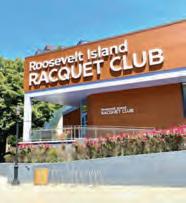


Advertising
To receive any information regarding advertising rates, deadlines, and requirements, call (516) 409-4444 or e-mail info@usptennis.com.
Article Submissions/Press Releases
To submit any material, including articles and press releases, please call (516) 409-4444 or e-mail info@usptennis.com. The deadline for submissions is the first of the month preceding the target issue.
To receive subscription information, contact (516) 409-4444 or e-mail info@usptennis.com or check out our Web site: www.nytennismag.com. Fax subscription changes to (516) 409-1600.
Statements of fact and opinion in New York Tennis Magazine are the responsibility of the authors alone and do not imply an opinion on the part of United Sports Publications Ltd. New York Tennis Magazine reserves the right to edit, reject and/or postpone the publication of any articles, information or data.
Features
6Metro Adult League Recap By Ainslie Ellis
22Parsa’s Picks: How Tennis Teaches Skills Beyond the Court
24USTA Eastern Metro Region Update
27Across Metro New York
28Character Building: Toni Nadal’s Six Core Values By Chris Lewit
30Entering The Competitive Universe By Ari Zuckerman
31ITF World Tennis Number: Everything You Need To Know By Leo Correa
46There Is Only One Way To Get To The Top By Dr. Tom Ferraro
52Developing The Complete Player With The Red, Orange, Green, Yellow Progression By Ray Josephs
54Are You Ready?



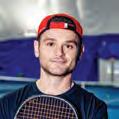





By Brian Coleman
Oneof the most important aspects for any young tennis player is having a coach they trust, and an environment in which they are comfortable.
And for players in the Brooklyn borough of New York City, MatchPoint NYC has provided that sort of environment, and that level of coaching. One of those players is Luca Ugel, a high school junior that has been playing at MatchPoint since he began his tennis journey more than a decade ago.
“I’ve trained at MatchPoint for 12 years now, and it has been great for me,” said Ugel. “I think if you want to get your child into tennis, MatchPoint is the place to start. They are really good with beginner players and make sure that every child is very happy.”
Ugel was one of those happy children when he began playing tennis at three-years-old. While that’s when he first started playing, growing up he also played soccer, and it wasn’t until a few years ago that he really leaned into tennis.

of the sport.
“Matchpoint makes it fun and interesting,” he said. “Especially my coach Eugene [Perepelov], he makes tennis much more enjoyable for me.”
Since he has committed himself fully to tennis, Ugel has become one of the best players his age, and heads into 2025 as the 10th ranked player in New York in the Boys 16s singles category.
Ugel is dedicated to improving his tennis and thus he takes positives and negatives away from both wins and losses, and then uses the week in between his matches and tournaments to work on the things he and his coach determine.
“It’s pretty simple, but I just focus on things that aren’t going good for me, or something that wasn’t working during a tournament,” he said. “It depends on how a match went but it could be anything from depth on my shots to solidifying my serve, and I am just trying to round out my game and be as consistent as I can.”
MatchPoint NYC has been with him every step of the way, and has helped him come along and nurture his love
That work has been important as for much of the last year, Ugel has been traveling internationally to compete in ITF tournaments, which has both tested him and allowed
him to see where he stands against players from all across the world.
“It has helped me learn in the way where I can see much clearer on what I need to improve on and what I need to do in order to achieve the level I want,” he said.
Ugel is an aggressive player who likes to use his power from the baseline to control the points, and he continues to work on improving his approach shots and coming in to the net more effectively.
“His will to go harder, faster, stronger and never giving up is what makes him a special player to coach. He always wants more and wants to improve, not only on the tennis court, but also physically by swimming, running, biking, as well as mentally by reading books and watching videos of his tennis idols,” said

Perepelov, Ugel’s primary coach at MatchPoint NYC. “Over the last few years, I have seen great improvement in his maturity. Making him more serious, more motivated
and more attentive to the smallest details such as stretching, warmup and resting his body and mind.”
The Brooklyn native is prepared for a new year and is looking forward to the next steps on his tennis journey, one that has come a long way over the course of the last few years. He has big goals and expectations for himself, and with one more year left in high school, the college recruitment process is on the horizon.
But for Ugel, he is not thinking about those macro goals as of right now, and instead has his sights set on the process, taking gradual steps to continue his progress, and the results will take care of themselves.
“Some goals for me are to start 2025 confident and strong, and continue building my game and getting better each day.”

By Ainslie Ellis

As we ring in the New Year, we hope your New Year’s resolutions include more tennis!
To that end, our winter leagues are just about to begin, including our 40&over adult leagues, 18 & Over Queen’s Mixed Doubles and 3.0/3.5/4.0 tri-level.
If you are interested in joining any of our leagues - specifically our 40 & Over Adult leagues…please contact Metro League coordinator Ainslie Ellis at ellis@eastern.usta.com.
We close out the 2024 league season congratulating our advancing Metro 3.5/4.0/4.5 tri-level teams: the women

captained by Huan Zhou and the men captained by Matt Murphy and Todd Mekles.
Best of luck to both teams in their Sectional tournament in Westchester January 17-19, 2025.
Finally, planning for our busiest season will soon be underway; be on the lookout for our Spring/Summer call for captains later this month.
And…..continued thanks to all of our captains and players. We are grateful for your participation in our leagues and all that you do to grow tennis.



•We offer a full-range of junior and adult programs for recreational and tournament players in partnership with Gotham Tennis Academy, a leader in developing and operating tennis programs in New York City and the Hamptons.
•Our professional tennis staff has some of the most talented, personable and engaging tennis professionals in NYC. For more information about our pros, please visit www.stadiumtennisnyc.com
•Sign up now for our popular Junior Programs, Adult Clinics, Private Lessons, and Seasonal Courts.
•Sixteen US Open style deco turf tennis courts with spacious backcourts. Twelve courts are indoors from October through April.
•For the convenience of our regular players and their families, the Tennis Center offers complimentary on-site parking and Transportation referrals.
•An adjacent clubhouse features a pro shop, light snacks and beverages, complimentary Wi-Fi, and workspaces for schoolwork.
•Please see our Safe Play Procedures summarized at www.stadiumtennisnyc.com

By Teddy Angelus
Iwasstuck in traffic recently and struck up a conversation with the Uber driver. He was a young man from Pakistan who has lived in the U.S. for 11 years. Married and about to become a father, he and his wife share a communal home with his brothers and their families. During our chat, he asked me if I ever feel lonely not living with my family. My first instinct was to respond with a witty remark about the challenges living with my family would present. But I paused for a minute during which he said, “Don’t you get lonely? Where do Americans go when they’re lonely?”
In March 2020, the White House launched the “15 Days to Slow the Spread” initiative to combat COVID19. Days later, travel bans were implemented, schools closed, churches shuttered, offices emptied, and most people began working from home. While the lockdown had a significant impact on many areas of our lives, for many, the feelings of loneliness and isolation were the most serious consequences.
We live in a challenging world right now. People are angry, disheartened, many even feeling disenfranchised. According to the National Institute on
Aging (NIA), “Social isolation is the lack of social contacts and having few people to interact with regularly.” It defines loneliness as “the distressing feeling of being alone or separated.” These issues, while not new, became undeniable during the lockdown—an uncomfortable truth that many of us are still grappling with.
Back in my Uber, I didn’t have an answer to my driver’s question. Later, I looked into it, assuming church might be the most popular destination for those seeking connection. However, data suggests otherwise.

Jeffrey M. Jones from Gallup.com reports that regular religious service attendance has steadily declined over the years—from 42% of U.S. adults two decades ago to just 30% today. Meanwhile, a study in USA Today shows that remote work is here to stay, and likely growing. And who among us isn’t guilty of connecting with the world primarily through a screen?
Growing up in New York City, I never gave much thought to connection. I’ve lived my entire life among millions of people rushing from one place to another. But one day, while at work at Roosevelt Island Racquet Club, I realized the foundation of connection is all around me. I joined the club because I loved tennis, but I’ve stayed because I love the community. In my early days, I thought the club would make a great sitcom or reality show, thanks to its memorable characters and compelling ensemble. Someday I might still pursue that idea, but for now, I’m just enjoying being part of this thriving, vibrant community.
You can play tennis anywhere, and it’s not hard to find someone at your level. But this club offers something unique. A relatively new member who came from a large, prestigious tennis club told me, “I could have been an active member there for a year without
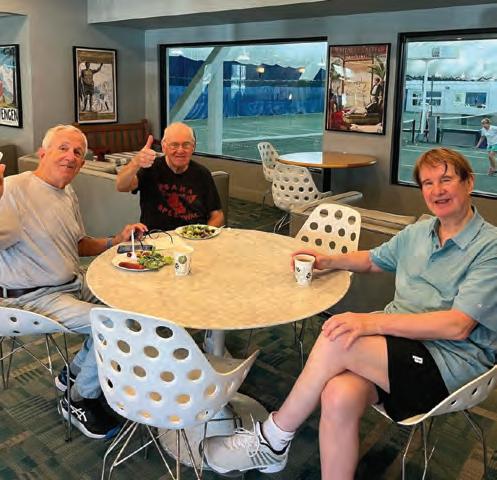
ever knowing anyone.” That doesn’t happen here. Roosevelt Island Racquet Club is a smaller, playerfocused club—a collective of players at all levels, members, non-members, coaches, juniors, seniors, and families—all brought together by a shared passion for tennis. There’s a lot more going on than 12 Har-Tru courts, lounges, locker rooms, and a gym. We get to know our members. When pairing up players, it’s not just the levels that matter. Compatibility is more than just a number. We try to find people who might have similar preferences or interests, be it on or off the court. People who might want to play again and again.
The strategy seems to work. There are members who have formed small unofficial groups of their own. They talk, laugh and continue their connection outside the club; actively, looking for others to welcome into the fold. While tennis may be the conduit, the result is a healthy, thriving community right here in New York City. Friendships are formed, connections are made.
We all know that tennis is good for the heart. But if my experience at The Roosevelt Island Racquet Club is any indication, it’s also good for the soul. Right in front of me, was the answer to the question my new friend from
Pakistan was asking. I watch a community grow and thrive every single day. Strangers, even rivals on the court, become friends, sometimes for a lifetime.
They break bread together. Dance. Party. Have fun. They show up to support one another on a regular basis. They watch their kids grow together, develop a sense of self, a healthy self-esteem and a love for all that tennis has to offer. They do what people in a community do. They connect.
As the cheesy ‘60s pop song goes, “When you’re alone and life is making you lonely,” don’t go downtown. Instead, grab your racquet and head to the court. Make that home court.

Theodore Angelus is a Father, Writer, Avid Tennis Player, Staff at the Roosevelt Island Racquet Club. Teddy is a long-time tennis player hailing from New York City. Born at NYU, he is a native New Yorker, who grew up on the Upper East Side. He learned to play in Forest Hills and was drawn to the competition and the joy of playing. Teddy was the captain of his varsity high school tennis team at Avon Old Farms. After moving to Roosevelt Island in 2019, he rediscovered his love for the game and found his way back to tennis. Teddy is now a valuable member of the Advantage Tennis Clubs team. He works at the Roosevelt Island Racquet Club and plays in a variety of leagues and programs at the facility.
By Brian Coleman
Atthe end of 2024, Madison Square Garden was home to professional tennis for the first time in nearly a decade, as The Garden Cup brought star power from the tennis sphere to the world’s most famous arena.
The night was filled with thrilling shots and unforgettable moments, with a lot of it coming from Emma Navarro, for whom the night was even more memorable.
“Just so special to be here playing in this arena,” Navarro said.
And while almost all athletes say things like that when they compete in famous arenas or stadiums, Navarro was being genuine. As a New York City native, Madison Square Garden is a sports and cultural landmark, and so for someone who grew up in near the arena, being able to play tennis there provided a unique opportunity.
Navarro would make the most of it, beating another New York native, Jessica Pegula, who grew up in Buffalo, 7-6, 7-5 to win the inaugural Women’s Singles event at The Garden Cup.
It was just an exhibition, and it won’t count towards the WTA Rankings, but the win was symbolic of the type of season Navarro had, a breakout campaign that made her known to tennis fans around the world.
“Talking about winning a Grand Slam, that’s something that was not even on my radar a few months ago,” Navarro said back in September. “So now to be in a position where I’m thinking about working towards winning Grand Slams is exciting, and it’s motivating.”
That quote came as she was in the midst of a run at the U.S. Open, just miles away from where she grew up in Manhattan. Navarro reached the final four in Queens to make the first major semifinal of her career, which came on the heels of her run to the quarterfinals at Wimbledon, a remarkable back-to-back showing for someone who had never been out of the third round at a Grand Slam prior to that.
She would fall to the aforementioned Pegula in the semifinals, but Navarro took a lot away from her result at the U.S. Open, and spoke about how meaningful it was to her.
“Playing in front of the American fans with the American flag next to my name, I have a lot of pride in where I come from. Being an American is something that’s really important to me,” she said. “I got to represent the U.S. in the Olympics earlier this continued on page 12


year. It’s something that I care a lot about. To come back and be able to play in the U.S., especially here in New York City, it’s pretty incredible. It’s definitely pushed me to sort of look back at where I started out and where I’m at now, and I feel like it’s only going to keep getting better. [It’s] really special playing here in New York.”
Navarro is the daughter of a billionaire founder of an investment firm and has parlayed her immense resources into a successful career of her own. Navarro has worked tirelessly to make her own name and achieve her own success.
The first couple of years on tour, Navarro methodically worked her way up the WTA rankings and cracked the Top 50 in the early part of 2023. By the end of 2023, she had ascended to 38th in the world, and entered the 2024 season with a full professional season under her belt, and her eyes fixated on continuing that climb.
losing to eventual finalist Jasmine Paolini in the quarterfinals of Wimbledon. “I know I’ll keep improving on it. I know this isn’t the last time I’m going to be in the quarterfinals of a Grand Slam. I know I’ll be back.”
After a decorated junior career, she joined the University of Virginia where she won the NCAA singles title in 2021, and as a result earned a wild card into the 2021 U.S. Open, where she made her major debut.
It began quickly as she won her first tour-level title at the Hobart International, and she continued her success from there. Navarro advanced to the fourth round of the French Open, and then defeated the likes of Naomi Osaka and Coco Gauff en route to reaching the quarterfinals at Wimbledon.
“I played the best tennis I’ve ever played in my life at this tournament. It’s really exciting to know I have that level inside of me,” she said after
And was that ever prophetic, as just a month later, she did get back to that stage at a Grand Slam, and took it one step further in New York. While the loss stung, it was just the latest stepping stone on a career that continues to trend in the right direction.
“I think something that I’ve been learning more and more is that there are pillars to my game. I think in the past some of those pillars have been day-to-day dependent on how I feel with a certain or shot or my confidence level with my game,” navarro’s new year continued from page 10
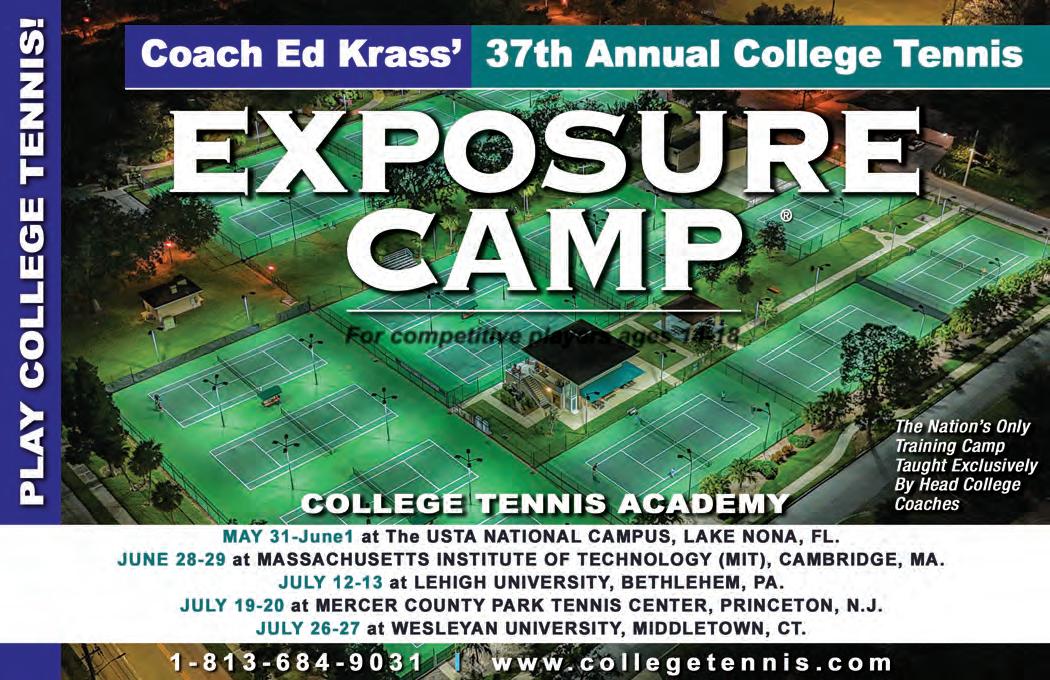
she explained. “I think I’m learning more and more that those pillars are non-negotaibles. It’s how I play and it’s who I am as a player. And accepting that if I can’t execute those parts of my game good enough on a given day, I can’t win that day. I think in the long run that will give me the best chance to win matches and have the best results. Long story short, just getting more comfortable and confident in who I am as a player.”
That level if introspection and understanding who she is, is a quality that will only lead to more success for Navarro, who is still only 23-yearsold and navigating who she is not only as a tennis player but as a person.
As a result of her 2024 success, the New York City born Navarro was named the WTA’s Most Improved Player, and she enters 2025 as the eighth-ranked player in the world, and is poised to build on that success as we begin a new year of professional tennis.








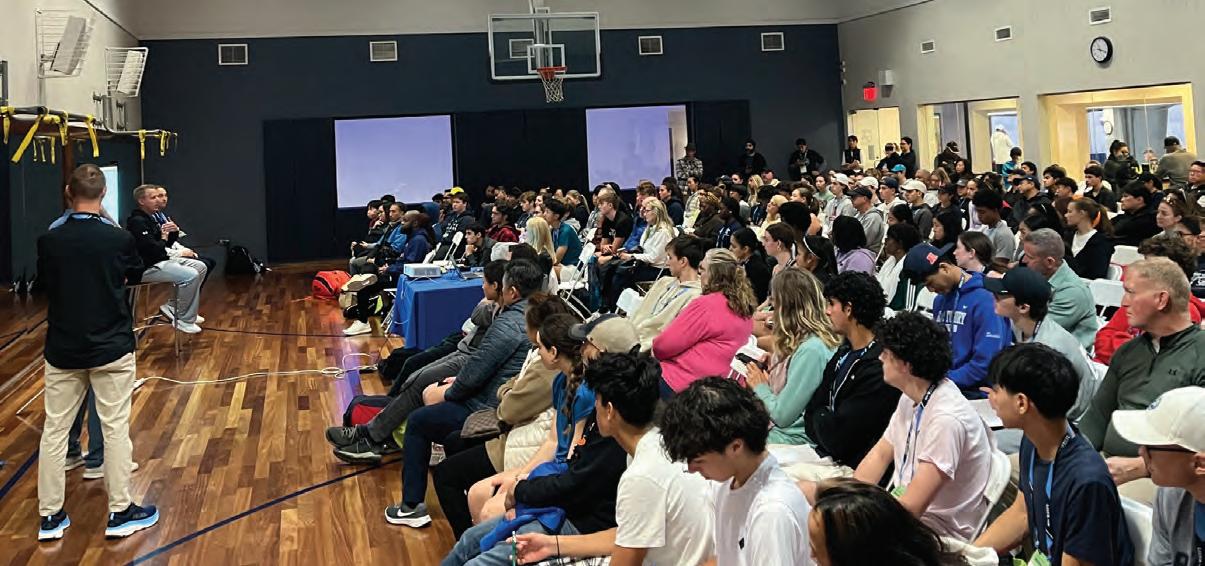
Asjunior tennis players get older and begin to look towards the next chapter in their careers, the college recruitment process is one of the biggest hurdles placed in front of them. For both the players and their parents, navigating the waters in finding the right collegiate fit is a difficult one.
The same applies to college coaches; searching for players to represent their program both on the court and in the classroom can be a daunting endeavor.
To help ease that process and bridge the gap, USTA Eastern has been integral. For the last four decades, the organization has operated its annual College Showcase, which connects players, parents and coaches for a day featuring on-court match play, clinics run by college coaches, lectures from experts and more. This year’s annual event took place in November at the Genesis Health Club at Saw Mill in Mount Kisco.
“We are excited and thrilled to hold this event every year. One of the greatest joys of my role at Eastern is watching the Showcase in action,” said Julie Bliss-Beal, Managing Director,


Strategy & Competition for USTA Eastern. “I love seeing juniors develop connections with potential future coaches. Many times a student will have not even heard of a particular school and then walk away from our event adding it to the top of the list. That’s always one of our main goals: facilitating introductions.”
The Showcase runs all morning and afternoon includes an array of different activities for both players and coaches to take part in. For the second straight year, college coaches ran clinics for high school freshmen and sophomores, guiding them through a variety of
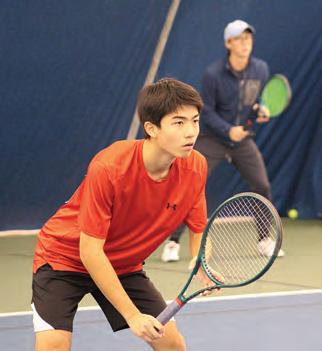
singles and doubles drills aimed to mimic a typical college practice.
Spread out across the 13 courts at the Saw Mill Club, players took part in match play, both singles and doubles, as coaches rotate around the courts and observe. This allowed players to demonstrate how they play against different types of competition, while coaches were able to see how these players handle pressure moments and match scenarios.
Kyanna Singh, who as a junior attended the Showcase as a player was there this year representing the University of Rochester where she is
now an Assistant Coach for both the Men’s and Women’s tennis teams.
“The Showcase was extremely helpful to me when I was an aspiring college player, it allowed me to demonstrate my skills in front of college coaches and gave me the opportunity to meet and have a conversation with these coaches,” Singh said. “The exposure helped me to understand how to start having conversations with coaches and it helped me navigate the recruiting process. Being on the other side at this year’s Showcase was truly a full-circle experience. I understood how critical it was for the players to make a strong impression on and off the court. As a coach, I was looking for players that not only had great skill on the court, but also had a great attitude to help them succeed at the collegiate level.”
As someone who has been both a player and coach at the Showcase, Singh knows both sides of the process, and was able to impart that wisdom

onto the players she communicated with. There are many aspects of the college process that go beyond how fast someone serves or how aggressive they are from the baseline, and this is where the Showcase is so imperative for high school-aged players.
Stephanie Marcharet, a junior at Syosset High School, is one of the top players in her age group, and she attended the Showcase. Marcharet
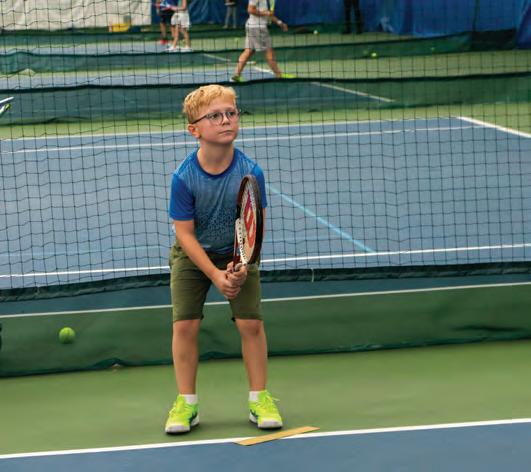


knew what she wanted to do to impress the coaches on the court, but also gained knowledge on things such as how to connect with coaches throughout the year.
“The showcase had great lectures that explained a lot of the recruitment platforms coaches use to look at players. What was also incredibly
continued on page 16

helpful was the talk that discussed the college essay. Before that, I was unfamiliar with what I’d do when I finally come to write it since I didn’t know much about the essay,” said Marcharet. “On court I was thinking of practicing the discipline to perform under pressure, from the pressure of coaches and other people watching. When I was interacting with coaches, I was interested to learn not only about the different schools but also how to converse and relate with different types of coaches.”
The coaches come from local schools and others across the country, and range from Division I, Division II and Division III programs, creating an allencompassing event that not only benefits the players that are destined to go to the top tennis programs in the country, but also those who are looking
for the perfect balance of tennis and academics, and ones that fit their individual needs.
For the last four decades, the USTA Eastern’s College Showcase Day has been a pinnacle event for the organization, and an integral one for its overall mission of growing the game.
The 2024 edition of the Showcase was another indicator of USTA Eastern’s desire to play matchmaker for studentathletes and colleges, and continue to ease a process that can oftentimes be difficult and stressful.
After a successful Showcase, BlissBeal the Eastern team are back at work already on how to continue improving the event as we move into 2025.
“As soon as the Showcase ends, we start thinking about how we can elevate the next one. We really value the feedback we receive through our post-

event surveys, and we will definitely integrate what we learn from those into the planning for 2025,” said Bliss-Beal. “We always like to bring current collegiate and former Eastern players to the event to speak about their own experiences with attendees. That ended up not being a part of the schedule this year, but it is always something we try to include. The feedback has been overwhelmingly positive. A lot of coaches very much value the opportunity to meet so many strong players in person in one location, and I personally heard from multiple parents who were really thankful we were able to share so many great resources at the event. College athletics and recruitment can feel overwhelming, and it’s everevolving. People are grateful that we can help them as they begin their journey.”
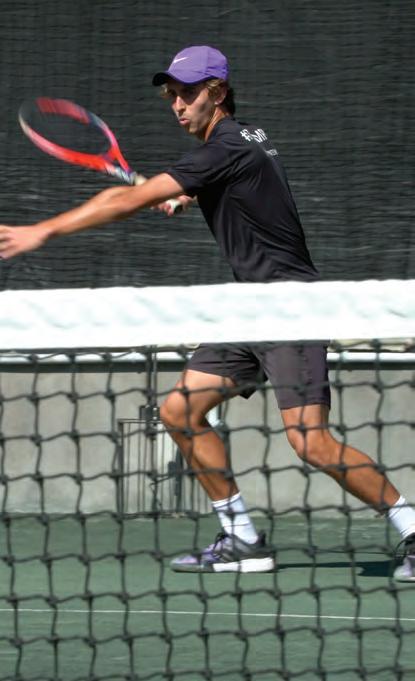
Distribution scheduled for 03/05/25
This edition will feature:
• Guide to the Top Tennis Camps
• Guide to the Top Court Builders & Manufacturers
• Boys’ High School Tennis Preview
• 2025 Australian Open Recap
• And Much More!
Print distribution across New York at 300+ locations.
Digital distribution across website and social media pages, and the e-Edition will be e-mailed out to our full database.

Don’t miss the advertising opportunities in the next edition of New York Tennis Magazine March/April 2025!
Facebook-www.Facebook.com/NewYorkTennis Instagram-@NYTennisMag • Twitter-@NYTennisMag Submissions for both advertising and editorial are due by February 5, 2025 For more information, please call 516-409-4444 or e-mail Advertise@NYTennisMag.com


TheMetro Corporate League’s Fall 2024 season came to a close in grand fashion as Roosevelt Island Racquet Club hosted the end-ofseason finals and party, bringing together the two finalists from each respective division, as well as players from other teams throughout the league.
The end-of-season finals is the culmination of a long season in the Metro Corporate League and features not only the championship matches in three of the league’s divisions, but also welcomes players and teams who did not reach the finals for an evening of catered dinner, open bar and fun atmosphere. While the players competed on courts, spectators were able to watch the matches and enjoy each other’s company in the viewing area of Roosevelt Island Racquet Club.

As happens in each season, the winners of the Advanced Division earns the trophy and keeps it at their corporate offices until the end of the following season, while the winners of the Advanced Intermediate moves up to the Advanced Division, and the winners of the Intermediate Division move into the Advanced Intermediate. Fall 2024 Champions:
Advanced Division: AlphaSights
Advanced Intermediate Division: J.P. Morgan
Intermediate Division: The E Team AlphaSights successfully defended its Advanced Division title from the Summer 2024 season, and will now be in search of a three-peat in the Winter 2025 season in the Metro Corporate League.
Shelly Yaloz, who captained the Advanced champions AlphaSights, said:
“The key to my team successfully defending the Advanced Division title this season was our dedication—both on the court and in the gym— combined with the unwavering support we showed each other,” she said. “The chemistry we built through consistent practice and teamwork allowed us to play as one cohesive unit. “I truly enjoy the high-level competition and networking opportunities that the Metro Corporate League provides. Traveling with my coworkers at the end of a workday to play the sport I love alongside other advanced players is the highlight of my week. I highly recommend the Metro Corporate League to other high-level or former college players. It offers a professional and positive environment where athletes can connect, compete, and unwind with bites and drinks.”






By Brian Coleman

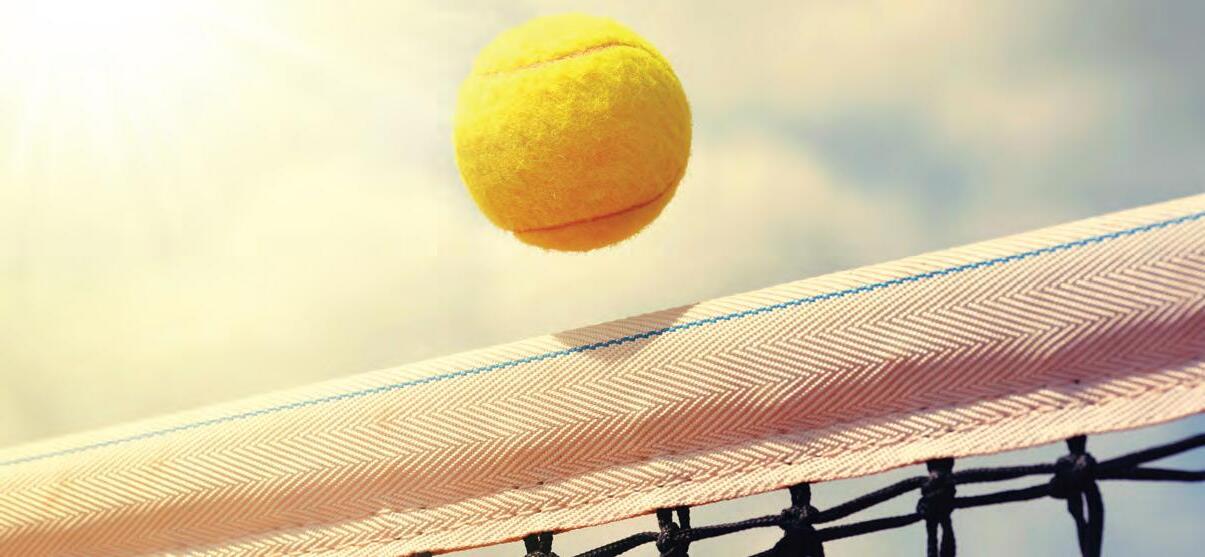
Ever since he can remember, Mike Levy has been a part of the family business.
When he was two-years-old, he started hanging around the hardware store his dad founded in East New York back in 1950, a store that would ultimately become National Metal Industries (NMI).
“I was always there when I was younger but really began working there around 13 or 14,” Levy recalls. “I got into working full-time when I was 18 and I’ve been here ever since.
NMI began its journey by offering a complete line of commercial hardware and fence supplies, and expanded its business in 1980 and moved out to Oceanside where it operates from today. NMI is still a family-owned business with no outside partners or stockholders, and for four generations it has taken pride in the fact that its products are all American made.
“Great products, great service and fair pricing is the foundation of our business and is directly responsible for our success,” is NMI’s tagline.
Levy takes a great deal of pride in the fact the business has always stayed in the family. Officially, his title is the Vice President of Sales, but at a family-run business, Levy is

a part of all aspects of his company’s tasks.
“I basically wear all hats; whether it’s sales, purchasing, or just the day-to-day processes. I’m basically a CEO-type,” explains Levy. “I get my hands into everything, and oversee the day-to-day happenings here. My mom still owns the company, and we continue the mission that my father had when he founded it all those years ago.”
NMI provides fencing supplies and more all across the country, ranging from commercial to residential properties, creating customized options depending on the needs of the client. This includes any supplies needed for the creation and renovations of tennis and other racquet sport courts.
“As a supplier, we never know exactly what our products are going towards, but we know that they are oftentimes being used for the purposes of tennis courts,” said
Levy. “We create a hedge that can go inside of chain link fences so that the whole fence looks like a hedge, which are used on a lot of tennis courts, as well as windscreens. We can do custom windscreens for your school or country club.”
And Levy says the key thing that sets them apart from the competition and larger companies is the personalized service, and unmatched customer support they are able to offer as opposed to big corporations.
“We can move faster than those major companies because their lead times are usually further out, and there are other moving parts that they have to go through,” said Levy. “We have a flexible pricing structure we are able to work through that allows us to work directly with customers to ensure their satisfaction and a job done on time.”
Levy’s tennis connection goes beyond his company supplying materials for courts. Growing up, he always enjoyed playing tennis, taking lessons at Point Set Tennis in Oceanside as well as Hofstra Day Camps.
And while he loved playing tennis, he admits he wasn’t the best athlete, something that can’t be said about his daughter, who is an avid tennis player. This past fall, she competed


on the Oceanside junior varsity team and has been playing tennis all of her life.
“Even though she is on JV, when she plays against players on the varsity team, she can hold her own.
I’m watching her grow as a player and person, and she loves tennis, which makes me very proud,” says Levy. “Just like any sport, young players move at their own pace, and they get stronger at certain points, so it’s been cool to watch that process.”
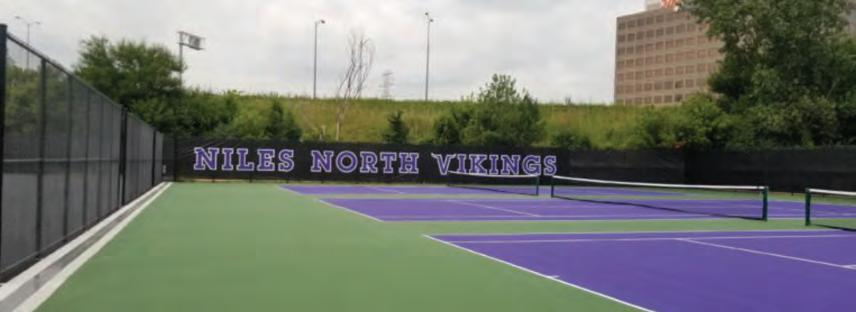
business world, which is something that Levy does not take for granted.
It’s that authenticity and commitment that makes NMI stand out amongst the rest, and why it has remained a stalwart in its industry for nearly a century.
She takes lessons at Point Set just like her dad all those years ago.
“She loves competing, and it’s just a great sport for her.”
That family connection is an important one for Levy, and it carries its way from the tennis court into the
Levy says:
“We have products for all types of properties; whether it’s a home or a country club, we can customize solutions for any customer needs, and can outfit any property.”
While we are in the midst of the
indoor tennis season here on Long Island, the spring and warm weather is not too far away on the horizon, which means it’s almost time to prepare those outdoor courts. Levy and his team are happy to discuss all the options they have available to get your outdoor tennis season started the right way.

Visit NMIFence.com, e-mail mike@nmifence.com or call (516) 594-0365 to learn more about what the Long Island-based, family-owned business has to offer.
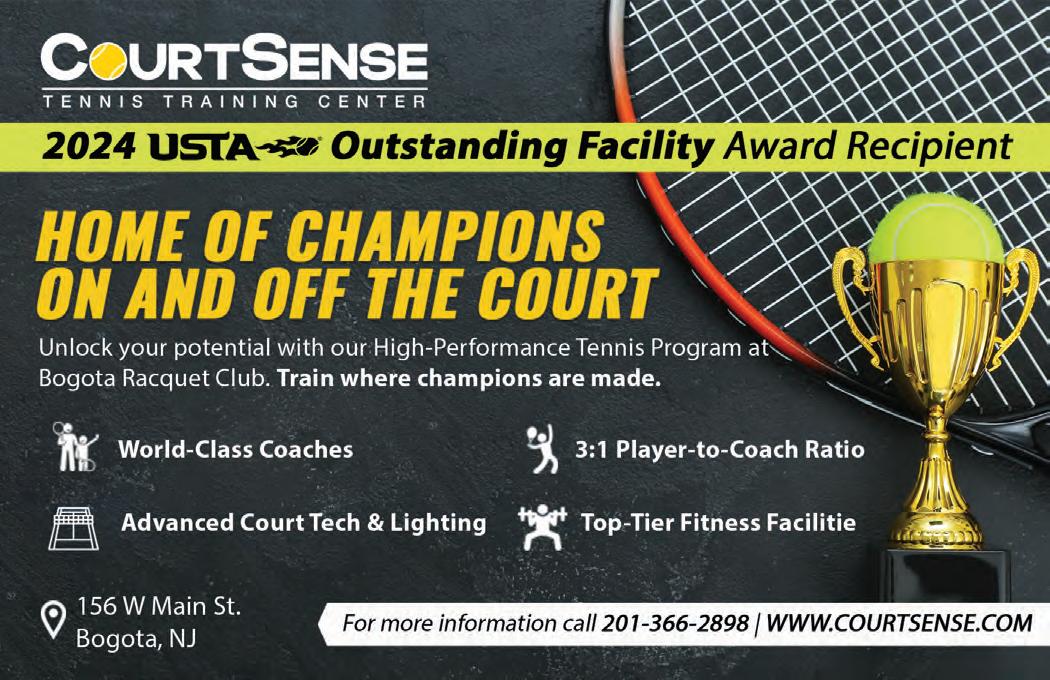

Tennis is the sport of a lifetime, and we see that manifested throughout the lives of so many people, especially here in our local community. The lessons learned and skills developed from being a tennis player can stay with you throughout your life and have benefits no matter what field you enter into professionally.
Parsa Samii was a high-level junior tennis player from Long Island who went on to play collegiate tennis at the University of Massachusetts-Amherst. Samii became a high-performance tennis coach before entering the real estate business, and is now a Licensed Real Estate Salesperson and a Member of the Compass Sports & Entertainment Division.
New York Tennis Magazine spoke with Parsa about his tennis background, what he does for a living, and how the former has helped him succeed in the latter.
NYTM: Talk about your tennis background. Where did you play as a junior growing up, what that experience was like and did you play in high school/college?
Parsa: I actually started playing tennis pretty late, at the age of 13. I started at Port Washington Tennis Academy which at the time was where all the best players in New York trained. It was on the heels of the Harry Hopman era there, and it was just a mecca for tennis. It was an incredible place; between the chocolate chip cookies and milk that were always there, and the chess games that were played between practices, and what felt like an unlimited amount of open court time and people to play with, many of whom were following and pursuing a passion just like you were. It was an incredible way to grow up. I was more of a basketball player initially, and so I was a bit behind when I got into tennis, but I was very competitive. I really just enjoyed the struggles, to be honest with you; the suffering that I went through because of that and wanting to be the best. Being years behind my competitors was something that I still value and cherish to this day, and the lessons that I've learned that I continue to lean on and use in my business today.
High school tennis and college tennis was interesting because it helped me get that team aspect. You are still competitive and fight for your position with your teammate, but then the next day, you play a match against a different school, and now you're brothers again. And so it's an interesting arena to be in with, competing with your brothers and acting like they're your brothers, and then the next day playing a ladder match to see where your position is going to
be. So there’s a lot to that. And the same thing happened in college. You know, all of it was rooted in passion and desire to continue to improve at something that was really difficult. I can't say that at the time it was the most fun thing in the world, but reflecting back on it, they were the best years of my life and some of the best moments of my life, and I wouldn't change it for the world.
NYTM: What did being a competitive junior tennis player teach you about yourself?
Parsa: Ever ything. I attribute my fitness level, my physicality, my mentality and my emotional intelligence largely in part to the years I spent playing junior tennis. At a young age, you're forced to reflect and see how you can improve. You're forced to deal with your emotions, and in order to perform at a higher level, you have to tackle all of these things that arise that you normally don't deal with as a kid. Whether it's anger, frustration, success or improvement, each and every day has its own challenge, and to learn to overcome those challenges and to live in the moment are some of the greatest tools that were given to me as a junior tennis player. And there is a lot of virtue in the experience. Without experiencing it, I couldn't really gain it. And I think that's a really important statement.
NYTM: What lessons or life skills did you take from tennis?
Parsa: A great question. I would say almost ever ything, but the major one is to have the sense of never quitting. I don't even think it's in my blood to quit at something, and a large part of that is because of these initial struggles in tennis. It’s a funny sport in that even if you play and do the right things, you can still lose. And you have to be able to reflect on it, make sure that you did what you needed to do in order to be successful, and that you performed well even though the result wasn’t what you wanted. Either the quality of the shots that you were hitting, or the tactics that you were playing, weren't exactly where they needed to be, despite your physical level being there. And so what that means is that you have to get back on the practice court tomorrow and keep getting better. So I think it also on a more macro level taught me that you could do a lot of the right things, and it could still not work out for you. What you really need to do is pick yourself back up, get back to work, do what you know is going to get you to the end goal, and continue to do the best you can.
NYTM: How have those lessons helped you in the business and real estate arena?
Parsa: To be honest with you, being a player then being a coach, and then moving into a completely different industry, I
had no fear, and I think that is probably the greatest gift that tennis gave me. I feel like I failed at every level, and as funny as that sounds to say, it's actually given me a ton of strength, because I approached real estate with that same mentality. I had already failed so many times that when people would tell me that real estate is a failure type of arena, and most people don't make it, it did not deter me. I said, ‘Alright, cool. I don't care. I'm just going to keep doing what I do. I'm going to keep doing the lessons that I learned on the tennis court, which are my daily habits, my daily practice, my due diligence every single day for every piece of business that I have. And I promise you, I will turn around more than the average agent does’. And the data shows that that is exactly what I've been able to do for the last three years. I finished last year as the number one agent on Long Island by sales volume, and that's strictly because of the little work that I do on a daily basis, and that comes from all the habits I built on the tennis court.
NYTM: What makes tennis the ideal sport for people of all ages to play? What do you love most about it, and why is it great for someone who requires a work-life balance?
Parsa: Tennis is a sport where you're challenging so many different aspects like the physical test of your hand-eye coordination, movements on the courts, bending and loading of your legs, hip turns, upper body strength, to the tactics and strategy that it that it takes in order to play and the emotional control required.
Tennis forces you, despite your frustration or despite your
exuberance, to stay level-headed. I think all of these things, no matter stage of life or your level, makes it a challenge. And you can always find that challenge out there, and it doesn’t always have to be in a competitive arena. It could just be playing with a friend, or taking a lesson.
I would like to play more, but I try to play once a week when I'm healthy, and it's a great outlet. Just this morning, I warmed up with my buddy and we hit back-and-forth for five straight minutes. It was the quietest my mind has been in a week since the previous time I played with him, and it's truly a remarkable gift that tennis has given me. When I get to step on a court, I get to lock life out and just focus on feeling the ball, feeling my body and feeling my breath. Being able to just take a step back and reflect is what makes tennis truly a gift for me. Unfortunately, schedules get very busy, especially with a family and young children, but I do try to make a point to play as much as I can.
Tennis has so many levels that it can be difficult to get into, but on the inverse, I think that’s what makes it so unique because there is always a level for you. What I love the most about tennis is pretty simple. It's the crack of the ball, it's the hitting of the strings, it's the silence that it creates; it's a space that nobody can enter. It's me, the ball and the opponent across the net, and really nothing else. It is one of the more simple things in life, at least for me. And the objective is to hit the ball over the net and inside the lines, and to do it better than the person on the other side. When I look at it like that, it's a refresher. Every single time I step on the court, I come back and I'm in a much better mindset and ready to tackle the day. I have always appreciated that and will continue to.

At Gotham Tennis Academy, we're passionate about teaching tennis. From beginners to rising stars, Gotham's PTR certified pros are experienced in teaching the fundamentals while stressing sportsmanship, hard work, and fun. With our prime location at Stadium Tennis Center - NYC's newest and largest indoor/outdoor tennis center, we're only a short trip away from you. It's more convenient than ever to get your kids into the game
To enroll now and learn more, please visit www.stadiumtennisnyc.com or call 718-665-4684.
Gotham Tennis Academy is a leading operator of innovative tennis programs in NYC and Montauk
RitaZhang’s journey to lifting a finalist trophy at the 2024 USTA National League Championships began with a literal journey: a 15-hour flight from Europe to Surprise, Arizona where the event was held.

“My husband is a professor at Columbia Business School and every seven years we spend an academic year abroad,” the captain of USTA Eastern’s 18 & Over 4.0 Women’s team explained. “When Nationals started, we were already in Belgium. So I had to fly 15 hours with two stopovers. I nearly missed my flight!”
It’s a good thing she didn’t. Under Zhang’s leadership, the New York, N.Y.-based squad displayed some blistering dominance in Surprise—particularly in the round robin stages of the tournament. Over the course of the first two days, the women amassed a 4-0 record against contingents from USTA Northern, USTA Missouri Valley, USTA Hawaii and home favorites USTA Southwest. Against the latter two, the USTA Eastern group won all five of their courts (the division plays two singles and three doubles courts) to head into the knockout rounds sitting at the top of the leaderboard. They recorded a staggering ten bagel sets along the way.
“Our team was strong because we had five good singles players who are also all solid in doubles,” Zhang said. “This flexibility allowed me to build an effective lineup during those first two days.”
In particular she cited heroics from teammates Clara Ceccaldi, Charlotte Reiche and Teagan Mach. Ceccaldi in particular laced up her tennis sneakers for all four matches and never dropped more than three games in a single court.
“They all possess great skills, and they all trained intensively after we won sectionals,” Zhang said. “Their focus and determination were key to all the 6-0 sets and
straight-set wins.” The Eastern players’ impressive form continued into their semifinal bout against USTA Northern California, as they went on to claim every single matchup to defeat their opponents 50. From their early-round encounter with USTA Hawaii to earning their spot in the final, the team ultimately recorded 15 straight courts in a row.
Unfortunately, the streak came to an end in the final battle with USTA Mid-Atlantic . As temperatures soared into the upper 90s in Surprise on the final day of competition, the Eastern group narrowly lost the final to their opponents 2-3. Narrowly, of course, is the operative word.
“In the third doubles match, which I played, we won the first set with ease, but then the heat got to us,” Zhang recalled. “The Mid-Atlantic players were just super resilient. We were up 5-1 in the super tiebreak but ultimately lost. It is incredibly difficult for a northern-based team to play in the heat. We were lucky that it was only so hot when the finals were played!”
Even in defeat, the team could appreciate everything they’d been through over the course of the season to get to play on the final day of the National event. At the local level, they needed to defeat an equally strong team twice just to advance to sectional competition. Then they squeaked out a sectional win in a final super tiebreak (and did so without a full roster). Through it all they became quite close.
“One of our Chinese teammates [who didn’t go to Nationals] gave Charlotte a stuffed animal dragon named Eddie as a lucky charm…it is the year of the dragon in the Chinese Zodiac,” Zhang said. “Charlotte brought Eddie to Surprise and it watched all our important matches!”
This kind of camaraderie is ultimately what Zhang and her
players will recall when she looks back on her expansive 2024 USTA League journey(s).
“The road to the nationals, and reaching the finals, has been an incredible memory for everyone,” she said. “The players were all motivated, supportive and positive. From
practice to room sharing, from meal planning to lineup planning, there was no drama of any sort. We were feeling down and some even cried when we lost in the finals, but that was all. It was an amazing experience! We will never forget this event.”

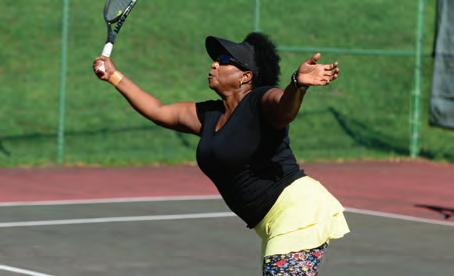
Timeflies when you’re growing the game. Dr. Sharon Simmonds just wrapped up her first term as USTA Eastern’s Metro Regional Council Director—and she’s only getting started: She’ll serve a second term beginning in 2025. Below, she looks back on two years leading the effort to attract more players to the sport across the five boroughs. When you think about your first term serving as Metro Regional Council Director, what would you say makes you most proud?
SIMMONDS: As I reflect on my first term as the Metro Regional Council Director, I am filled with a sense of pride and accomplishment. This journey has been both rewarding and enlightening. What makes me most proud is the strong sense of community we have fostered within the Metro Council. I have had the privilege of collaborating with passionate individuals dedicated to expending the energy and efforts needed to grow the sport of tennis. I thank the council for their unwavering support and commitment to growing tennis in our community. It has been incredibly fulfilling to witness the growth and enthusiasm for the sport in our region.
Are there any specific projects over the last two years that you particularly enjoyed working on?
SIMMONDS: One project I really enjoyed was the Metro Junior Council’s “Grateful Games”, held at Cunningham Indoor Facility. This event was born out of a desire from our Junior Council Chair Olivia to give back to the community
while sharing her passion for tennis. With the help of the other council members, we helped her organize a food drive built around a tennis clinic. I enjoyed working on this initiative because it offered Olivia and the other junior council members the opportunity to display their organizational and leadership skills. This event also created a vibrant environment for aspiring players. Seeing the excitement on the faces of the participants as they learned and improved their tennis skills was truly heartwarming.
What have you learned about the Metro tennis community during your time as director?
SIMMONDS: Over the last two years, I have learned that the Metro tennis community is not just a collection of players and clubs, but a supportive network of individuals who are passionate about the sport. The camaraderie among players, coaches and volunteers has really been inspiring. I have witnessed the impact of our initiatives firsthand and learned the importance of community engagement. I have also observed the importance of inclusivity in our programs. We absolutely need programming that ensures tennis is accessible to all, regardless of background or skill level.
What did you learn about yourself getting to serve in this capacity?
SIMMONDS: Personally, serving in this capacity has been a profound learning experience. I have discovered the value of leadership and collaboration, and how vital it is to listen to
continued from page 00
all the voices within our community. It has taught me to be more adaptable and open-minded, especially when faced with challenges. I have also come to appreciate the importance of being a mentor and role model for others, which has motivated me to become even more involved in outreach and support initiatives.
What have been some of your best experiences growing tennis at the local level over the past two years?
SIMMONDS: One of my most memorable moments occurred during a community event last summer. We had a group of kids from various backgrounds, each with their own unique stories and challenges. One young girl, who was initially shy and hesitant, gradually opened up as she started to improve her skills. By the end of the event, we organized a friendly match, and seeing her smile as she scored her first point was incredibly rewarding. In that moment, it was clear to me how our efforts were not just about teaching tennis but also about building confidence and joy in our young athletes.
You will begin your second term leading the Metro Region beginning in 2025. What are some of your goals for the future?
SIMMONDS: Looking ahead, I am excited about the
Wepotential initiatives we can focus on in 2025 and beyond. One way I believe we can expand is by bringing our outreach programs, such as Red Ball Tennis (adult and kids), Social Play (adults and kids), to underserved communities. Our commitment to diversity, equality, inclusion and accessibility is something I believe we should continue to prioritize. By providing more scholarships, coach development and free clinics, we can ensure that tennis becomes accessible to all, regardless of their background. Additionally, I would love to see an increased emphasis on wellness programs that integrate tennis with mental health awareness, particularly for youth and adults facing challenges.
Is there anything you'd like to add about your experience over the last two years?
SIMMONDS: Over the last two years, my experience in tennis leadership at the regional level has been immensely fulfilling. I am proud of the strides the Metro Region has made and optimistic about what is to come. Our collective dedication to making tennis a sport for everyone is truly inspiring. I am excited about the opportunities that lie ahead for our tennis community. I look forward to continuing this journey together with the members of the USTA Eastern Metro Council to promote the sport we all love.
cordially invite you to attend our 2025 Eastern Tennis Conference, headlined by former top American male professional player and 2018 Wimbledon semifinalist John Isner—and featuring a session with USTA Community Tennis Chief Executive Craig Morris. This event is for everyone in our tennis community! Coaches, parents and junior athletes, USTA League and tournament players, club managers and tournament directors, CTA and NJTL leaders, volunteers and anyone else interested in the future of the sport should join us January 24-25 at the Genesis Health Club at Saw Mill (77 Kensico Drive) in Mount Kisco, N.Y. for new tennis technology demos, on-

court sessions led by top section instructors, informative panel discussions (including a USTA Leagues Q&A with USTA Eastern Director of Adult Competition Susan Friedlaender) and so much more!
Isner will highlight three sessions at the conference: an on-court clinic for coaches on Friday afternoon; an on-court doubles strategy workshop on Saturday; and a wide-ranging Q&A and on-court exhibition Saturday, which will also feature former Eastern junior and 2014 Wimbledon junior boys champion Noah Rubin. Morris will lead a discussion on how coaches can really make an impact in the tennis ecosystem. See the full schedule of events and register at usta.com/ETC2025.




… News and notes from across the N.Y. Metro tennis community News and notes from across the N.Y. Metro tennis community



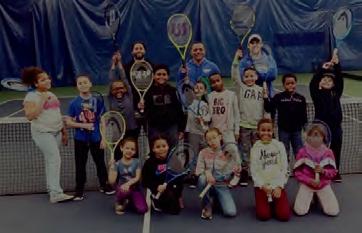
Many students from the Dwight Global Online School participated in the Orange Bowl International Tennis Championships, one of the most prestigious junior tennis tournaments in the world, with a number of players from the New York City-based school competing in Florida: Claire An, Mark Krupkin, Shannon Lam, Dominick Mosejczuk, Charlotte Narti, Navneet Raghuram, Reiley Rhodes, Lev Seidman, Matt Shapiro, Nischal Spurling, Nicholas Mekhael and Olivia Payne.

Columbia men’s tennis junior and three-time AllAmerican Michael Zheng, who trained at Centercourt Tennis Academy and attended Dwight Global, won the NCAA singles title after defeating Michigan State’s Ozan Baris, 6-2, 4-6, 6-2 to claim the singles crown.
Zheng is Columbia’s first NCAA singles champion of the modern era and is the first Lion to win a singles title since


Robert LeRoy won the title in both 1904 and 1906. Zheng is the first men’s singles champion from an Ivy League school since Lucien Williams (Yale) won a title in 1922.
“Honestly, it’s a huge relief,” Zheng said on bouncing back from his runner-up finish earlier this year at the spring NCAA Championships to now winning the NCAA singles title this fall. “It feels amazing to finally get it done and get the title for myself and Columbia.”
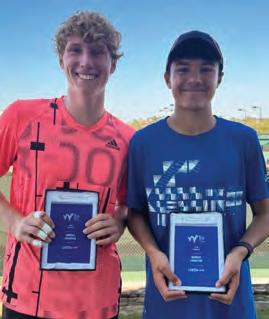
Zen Uehling, who plays at CourtSense Tennis Training Center, teamed up with Connor Plunkett to win the L3 Closed event. The pairing won the Boys’ 18s Doubles title, coming back from a set down in both the semifinals and the finals to win.

John McEnroe Tennis Academy player Jack Reis was the winner of the L4 Open in Quakertown, Pennsylvania. Reis had to win two three-set contests in the tournament before winning the championship in straight sets to win the Boys 18s singles division.
By Chris Lewit
The below is an excerpt from Chris Lewit’s new book, The Secrets of Spanish Tennis 2.0, which was released in December and is now available in bookstores and on Amazon. First and foremost Toni lives by a strict moral code. “Even if the world is finished tomorrow, I do the right thing—that’s values. Values affect everyone and everything in the world.”
In addition, his system is not only a powerful way to develop good tennis players, but it is a pathway to develop good human beings and a better society-better citizens of the world. To me, this is part of the genius of his approach and the value his principles hold for others, whether they are coaches or parents. Toni himself has said, "It is more important to be a good person than a good player.”
Based on this core belief, Toni has created a six point development model for the players he oversees at the academy. Here is my interpretation of these points, based on talking to Toni and on other reading and research into his thoughts.
The value of humility is very commonly taught in Spanish tennis. Humility can be exemplified by champions like Nadal, Carlos Moya and Juan Carlos Ferrero. “Humble is the way you have to be, period,” Toni says. He continues, “Everybody should know their place in the world. The point is that the world is quite big enough already without you imagining that you're big too.”
Rafa himself has argued that humility is a key component to his motivation and competitiveness because his humility never allows him to overestimate an opponent and become complacent going into battle.
2.
Toni believes that life in general has gotten faster, and that children and sometimes
parents expect instant results and gratification … quick fixes. But for Toni, the things that have the most value in life are difficult and take a long time to achieve. Thus, having the perseverance to overcome obstacles is a very important value and overcoming challenges is what helps to build a strong character.
3. Respect
“Respect for other people, for everyone irrespective of who they might be or what they might do, is the starting point of everything,” Toni tells John Carlin in an interview for the book, Rafa. “What is not acceptable is that people who have had it all in life should behave coarsely with other people. No, the higher you are, the greater your duty to treat people with respect.”
Furthermore, Toni believes that if you respect others, you will be happier in life, and thus happier on the difficult journey towards becoming a champion.
4. Patience
Patience is a common value taught to players in Spain. For Toni, one must, of course, be patient on the court to develop one's strategy. Moreover though, in life, one must never become impatient on the long and difficult journey towards achieving greatness; patience is thus interlinked with persistence.
5. Tolerance
Tolerance, for Toni, is connected to the value of respect. For Toni, people in life who have a high tolerance of those around them are more respectful and peaceful, and thus happier in their life. But Toni also believes tolerance is an important character trait in champions on the court. Tolerance, in this case, means how a player handles the stress and mental/emotional challenges of the battle. Strong players are able to tolerate
more stress and pressure than weaker players. Therefore, tolerance is also interwoven with the concept of selfcontrol. Toni says, “Self-control is critical to becoming a champion. A player must control their mind, body and emotions. Without this, he cannot control the ball.”
For Toni, fighting spirit means being willing to "suffer.” Sometimes he calls it "enduring."
Toni believes champions must endure and suffer--they must fight to the end to achieve greatness. Fighting spirit means never cave in.

Rafa says his uncle taught him this: “Endure, put up with whatever comes your way, learn to overcome weakness and pain, push yourself to the breaking point, but never cave in. If you don't learn that lesson, you'll never succeed as an elite athlete.”
These six core values are the infrastructure around which a coach can build a champion's mind and spirit, one that dominates without making excuses. Above all else, Toni says, “Champions must find solutions, not excuses. Whining and complaining never helped us win a match or championship.”
In addition to his model of six core values for players, Toni has also summarized his player development philosophy with the following three overarching principles: Technique, Character, and Propriety.
Technique for Toni Nadal, means developing all the skills a player needs to control the ball and to make the ball go where he or she wants. For Toni, this does not mean the strokes have to be
perfect--far from it.
He has always emphasized being able to put the ball where a player wants and finding the right skills for a player's personality and style--a practical approach to technical development, rather than forcing every player to achieve some abstract perfect form.
“But what is that, technique? Is it hitting the ball very hard and with a beautiful movement but once out of every two hits, it lands outside the court? Is it to have a very good forehand, a very good serve but no backhand? No. For me, technique is about being able to place the ball wherever you want it to land no matter what shot.”
Character, for Toni, very simply means working relentlessly towards achieving one's goals. He states, “A well-formed character is one that has been prepared to withstand the harshness of daily effort, the will, the development of selfimprovement capabilities, and, not least,
the enthusiasm to do so.” Character relates directly to: Overcoming Obstacles, Patience, and Fighting Spirit.
Toni Nadal believes that propriety-respect and good manners--is critical to achieving a happy life and good performance on the court. He says, "Respect and good manners bring happiness in one's life."
The efforts of Toni Nadal with Rafa have been well documented, but his teaching method and philosophy have been more obscured over the years. This chapter has shared some insight into the approach and philosophy of

the man who has had the greatest grand slam success with his player of any coach in Spain’s history. Nadal’s method interweaves the six secrets of Spanish tennis with his strict moral code. Toni’s unique brilliance can be found in his character building and the strategic vision for his players. He delivers his method with an economy of words, no excuses, hard work and a willingness to suffer.
Learn more about the drills and philosophy of Toni Nadal and many other leading Spanish coaches in the new book, Secrets of Spanish Tennis 2.0, the second edition of the original best-seller and classic. Available at local bookstores and all online outlets like Amazon.
Chris Lewit is a leading high-performance coach, educator and author of the best-selling book, The Secrets of Spanish Tennis, and a new technique book, Winning Pretty, which will be published in 2025. Secrets of Spanish Tennis, Second Edition will be published in September 2024. As a coach, he has trained hundreds of nationally ranked juniors. He directs a full-time academy for homeschool/online players and a high performance summer camp program, as well as bespoke high performance training for all ages and levels, all at his club in the beautiful green mountains of Vermont. Contact Chris directly by phone/WhatsApp 914-462-2912 or chris@chrislewit.com.


FULL-TIME ACADEMY FOR HOMESCHOOL PLAYERS WEEKEND HIGH PERFORMANCE ACADEMY TRAINING FOR ALL LEVELS HIGH PERFORMANCE SUMMER CAMP IN VERMONT TRAIN WITH THE BEST— CHRIS HAS RECENTLY COACHED SEVERAL #1 PLAYERS IN THE US!

By Ari Zuckerman
For many players, at any age, entering the competitive tennis realm can be quite daunting.
“Can I handle losing?”
“What happens when my nerves kick in?”
“My parents are watching me now. I don’t want my parents to watch me.”
“I’ve been practicing this game now for five years, but what if my mind goes blank and cant remember all the skills I’ve acquired”
These are certainly thoughts that enter the minds of any player who will be competing for the first time, or even players who have competed forever.
Navigating the multiple play opportunities can also be troubling, since there are UTR events, USTA Level 7, USTA Level 6, Team Tennis, Club Matches, high school matches…the list goes on.
After being a part of the tennis world since 2008, I wanted to share some (hopefully helpful) advice, which I believe will lead to new player success.
I will first share my advice for younger players, those ages 10 and under. At this age, I would
certainly recommend skill development as a priority. When your young athlete is confident in their serve and rally skills, only then should they start competing. They don’t have to serve like Isner or rally like Djokovic, but they should be able to place at least 50 percent of their serves in the service box and rally back and forth at least 3-5 times.
The USTA and UTR do offer entry level Orange & Green ball tournaments, which are the best places for youngsters to begin their journey. These are generally round robin or compass draw formats, and all players play multiple matches against players their own ages.
For older players, ages 10+, who are just starting to compete, there’s no better substitute than simply practicing in clinics,

privates, hitting with friends, until you feel ready to hit the competitive circuit. This age group should begin by competing in UTR match play, as well as USTA Level 7 and Level 6. USTA Level 7 events are typically one day events, in a round robin or compass draw format, while USTA Level 6 are typically 2 or 3 day events, with larger draws and higher level competition.
Parents, I would always advise you to be patient with your child’s development. There’s no rush to start entering the world of competition. However, if they do start asking, and start to get the itch, then let’s get them going! All they would then need (in addition to your wallet and being their Uber driver) is your support.
I hope these tidbits help out on your competitive journey!

Ari Zuckerman is the Vice President of Centercourt Club & Sports. He graduated from the University of Massachusetts as a Communications and Political Science Major. He started his career with Centercourt in 2008 as a Tennis Professional and Junior Tennis League Director and manages the tennis box leagues Centercourt UTR matches. His involvement at Centercourt Tennis includes Red Ball, Junior and Adult Leagues, Match Play and Round Robins. He can be reached at ari@centercourtclub.com.

Foravid tennis fans and players, understanding the importance of the ITF World Tennis Number (WTN) is crucial. In this article, we will delve into what the WTN is, how it is calculated, and why it matters in the world of tennis.
The ITF World Tennis Number is a system introduced by the International Tennis Federation (ITF) and endorsed by the USTA to provide players with a universal measurement in the form of a rating that can be used across different countries and tennis organizations. It is designed to give players a clear indication of their skill level and to help match them with opponents of similar abilities.
The WTN is calculated based on a player's match results, taking into account factors such as the level of competition, type of match (singles or doubles), and the outcome of the match. The algorithm used to calculate the WTN is constantly being refined to ensure accuracy and fairness for all players.
Having an accurate WTN is essential for players looking to enter tournaments,


By Leo Correa
find suitable opponents, or track their progress over time. It provides a standardized measure of a player's skill level, allowing for fair and competitive matches to take place. Additionally, many tennis organizations and clubs now require players to have a valid WTN in order to participate in events.
Here at the USTA Billie Jean King National Tennis, we incorporate the WTN into our programs in a number of ways. Whether in our WTN Match Play, session class groupings, or production of our USTA Eastern Junior Team Tennis teams, accuracy is paramount to helping players grow and ensuring parents have their juniors in the proper level-based training pods.
If you are looking to improve your WTN, there are several steps you can take. Firstly, focus on improving your







technical skills and match strategy through practice and coaching. Secondly, actively seek out matches with players of similar or higher skill levels to challenge yourself and improve your rating. Finally, maintain a consistent match record and strive to achieve positive results against tough opponents. By following these tips and putting in the effort to improve your game, you can gradually increase your WTN and showcase your talent on the tennis court.
In conclusion, the ITF World Tennis Number is a valuable tool for players looking to assess their skill level and compete in a fair and competitive environment. By understanding how the WTN is calculated, why it matters, and how to improve it, players can take their tennis game to the next level and enjoy all the benefits that come with a strong WTN.






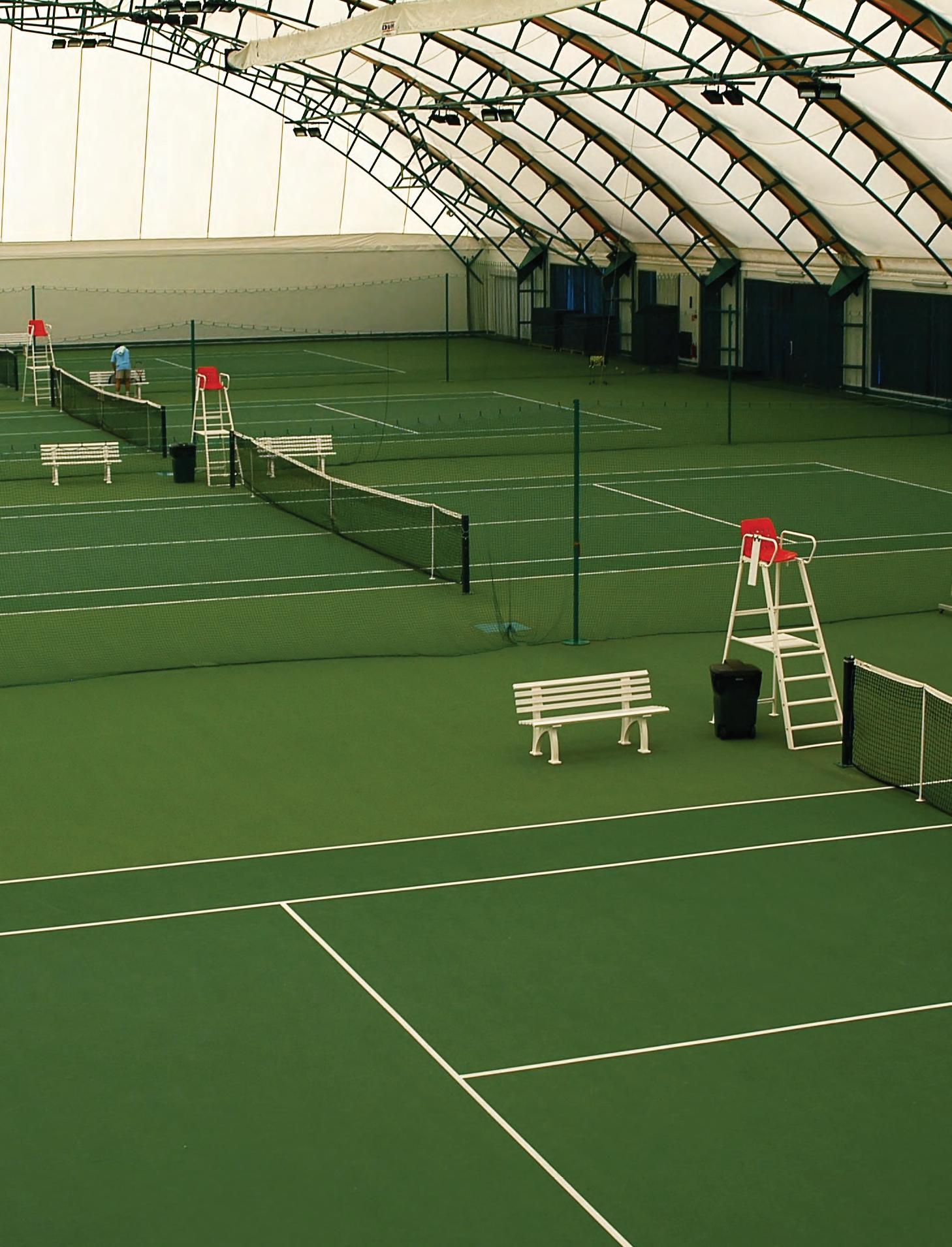
Your 2025 Guide to New York Tennis Magazine’s Top Clubs & Programs
New York tennis players have great choices when it comes to where to play tennis. We have compiled a list of some of the top clubs and programs with descriptions of what each has to offer.
l (212) 594-0554
Between 9th & 10th Avenue Off of 43rd Street l Open Ever y day 6 a.m. - Midnight

Advantage Tennis Clubs (HCK Recreation, Inc) is one of New York City’s oldest and premier indoor tennis and racquet clubs. With three impressive locations and an extensive tennis teaching and summer camp network across the city, our days are focused on providing the best in the dynamic sport of tennis and racquet sports. With more than 50 years of history and a massive influence on the city’s tennis game, we serve racquet sports players from the age of four to the age of ninety! We are not the biggest tennis experience providers in New York City, however, we aim to be the best and are consistently developing our team to achieve that goal.
MPRC offers year-round temperature-controlled indoor tennis with five beautifully surfaced hard courts in the heart of Manhattan. Come check out our:
• Five Hard Courts
• Private Lessons and Group Lessons for all ages and levels
• Game-Arranging
• Leagues
• Kids Tennis Camps
• Doubles and Singles Match Play
• Stringing Services
• Locker Rooms
• Discounted Indoor Parking available on the premises
MPRC membership includes a full membership to Manhattan Plaza Health Club which allows access to:
• Fitness Classes
• Climbing Gym
• A Fitness Gym
• Glass-Enclosed Swimming Pool
• Sauna and Steam Room
MPRC offers several categories of membership, including the Advantage Passpor t MultiClub Membership to Roosevelt Island Racquet Club & Sports Park and the New York Tennis Club.
Call now at (212) 594-0554 to explore Advantage Tennis Clubs Passport Membership or for more information about any of our offerings!



Every day 7 a.m. - 11 p.m.

Come check out our:
• Free Parking
• Adult Beginner Learning Programs
• Game Arranging & Clinics
• USTA Sanctioned Tournaments
• Advanced Junior Development Program
• Updated Clubhouse and Lounge
• Locker Rooms
• Stringing Services
Founded in 1886, New York Tennis Club is the oldest active tennis club in New York. With six HarTru courts in a quiet corner of The City. A short, thirty minute drive from both the Upper East Side and the Upper West Side, NYTC is a tennis lover’s respite from the hustle and bustle of our daily city grind.
Passpor t memberships includes free summer court time on reserved courts at Roosevelt Island Racquet Club (RIRC) and New York Tennis Club, plus membership privileges at Manhattan Plaza Racquet Club. Call now at (718) 239-7919 to book court time and explore our offerings!



281 Main Street l Roosevelt Island, N.Y. l (212) 935-0250
Take the F train from Manhattan or Queens to Roosevelt Island or take the tram from 60th Street at 2nd Avenue Open Every day 7 a.m. - 11 p.m.

New York City’s oasis on Roosevelt Island with temperature-controlled indoor tennis all year round. The Club features 12 well-maintained HarTru courts and an expansive and comfortable clubhouse. Easily accessible and just minutes by train and by tram from both Manhattan and Long Island City – Roosevelt Island is still an undiscovered secret for great indoor tennis facilities for both Manhattan and Astoria.
Come check out our:
• Beginner Tennis Lessons
• Intermediate Group Lessons
• Advanced Match Play
• Cardio Tennis
• Social Parties
• Junior Development Program for any skill level of children 4-17 years old
• Summer Camps
• Comfortable Lounge
• Locker Rooms
• Gym and Fitness Area
• Stringing Services
• Free Parking
An Advantage Roosevelt Island Racquet Club membership includes free summer cour t time on reserved courts at Roosevelt Island Racquet Club (RIRC) and New York Tennis Club along with complimentary game arranging other great social perks at the club!
Call now at (212) 935-0250 to explore Advantage Tennis Clubs Membership or for more information about any of our offerings!



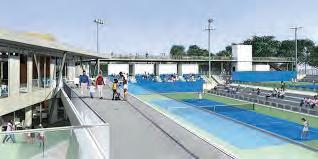
The Cary Leeds Center for Tennis & Learning houses a two-story, 12,000square foot clubhouse, educational spaces, and access to 20 courts (10 bubbled for winter/indoor use) and two stadium courts that seat up to 800 spectators. Led by a world-class team of tennis professionals offering programs and private lessons for juniors and adults of all skill levels, the Center also hosts summer camps, tournaments and community-based events.
The Cary Leeds Center for Tennis & Learning is the flagship home of New York Junior Tennis & Learning (NYJTL), the largest youth tennis and education non-profit in the nation. In serving its larger mission, the Cary Leeds Center provides 6,000 hours of free tennis court time to the community.




Centercourt Tennis Academy boasts the toughest playground in the Northeast and has created a true culture of excellence as proven by results: with countless players competing at the highest Collegiate Levels and several Full Time Alumni playing at the Professional Level, including 2024 NCAA Singles Champion Michael Zheng. Established in 1974, Centercourt® Club & Sports has become a leader in sports programming in the Northeast. Our portfolio consists of 8 sports training facilities that are focused on delivering top-level year round training. Centercourt’s Performance Tennis home base is located in Chatham, N.J., conveniently located 45 minutes from New York City with transportation and boarding options available.
Coaches - Our World Class coaches have walked the pathway and take pride in delivering only the best cutting edge Player Development Programs which are personalized to the needs of each athlete. Centercourt’s methodology is well-proven with the number of graduates finishing in the Top 10 ITF Juniors including 3 Wimbledon Finalists.
Academics + Strength and Conditioning - Our Strength and Conditioning Programs are a true point of difference at Centercourt With Global Leaders training players daily our Athletes are physically and mentally at their peak. Regular fitness testing, reporting and program adjustments ensure to prioritize players’ individual needs. Centercourt encourages a tennis culture of excellence and places a strong emphasis and focus on academics and work ethic. Centercourt offers schooling through ICL Academy, Laurel Springs and The Dwight School.
Competition - We believe that Competition is the backbone to development with players competing locally, nationally and at ITF level regularly. Centercourt’s full- time athletes become proficient in technical through the use of our SMAP Video Analysis Programs and also undertake regular seminars on Mental Toughness, Match Analytics, Nutrition and other key areas of development as well as bringing in guest speakers often. We also use cutting edge technology for match play charting, feedback and analytics.
Environment - We strive daily to ensure that our objective is clear—to ensure our environment always feels like home to our players. Our key priorities are to be Challenged, Growth orientated and Tough in every situation. Our Fitness Centers are incredible and we believe in maintaining our standards of Facilities and Coaches through mandatory ongoing Coach Education.
Centercourt® Pathway - The pathway starts early with our specialist NEW! Red Ball Development Center. We have a dedicated area for young players to become athletes under specialist coaching. The foundations of Elite Players are formed through Technical and Tactical skill development using key footwork patterns and cutting edge teaching methods in conjunction with our established curriculum. Visit Centercourtacademy.com for more information on after-school programs, specialized weekend training and our Full-Time Academy.




Chris Lewit Tennis Academy (CLTA) is a serious high performance academy set in the natural paradise of Vermont. The club offers European style red clay courts and indoor hard courts, gym and clubhouse. We never get rained out! Families love to visit nearby Manchester, Vermont, known internationally as a mountain tourist destination for its quaint village and charming shops and restaurants. We are also looking for families to move to Manchester full-time to train with Chris personally every day!
CLTA offers year-round full-time training, short-term training, and a world-famous high performance boarding summer camp. We have holiday and school break camps running all fall, winter, and spring. Players get to work on court directly with Chris. Chris is not just a figurehead; he is active on court working with players in the trenches daily. That’s what makes CLTA unique and special, and that’s why players come to train with Chris from all over the world.
Chris Lewit is one of leading high-performance junior development coaches in the United States. Author of the best-selling book, The Secrets of Spanish Tennis 2.0 and Winning Pretty, Chris has spent the last 20 years studying with many of the legendary coaches in Spain and Europe. He brings the most cutting-edge training methods from Europe back to the U.S. for his students. Chris is known as an expert in technique and biomechanics, and in Spanish training methods. He has recently coached the number 1 player in the US and gold ball winner Maggie Sohns, Ukrainian phenom Vlada Hranchar, and numerous top 10 nationally-ranked juniors, one Little Mo National champ Elana Zaretsky, and one national finalist Henry Holtz, and many elite players now graduating to the pro circuit. He also has unmatched experience building the foundations of young prodigies.
CLTA offers a unique teaching system based on the Bruguera Method, Toni Nadal Method, and the system of William Pato Alvarez—all from legendary coaches in Spain. Chris is one of the only coaches in the world who has attained certification in these three systems, and he brings unparalleled experience to this who want to train authentically the Spanish Way.
Chris is known internationally for his expertise in technique and biomechanics, and he is currently studying for an advanced degree in kinesiology. CLTA features cutting edge sports science, athletic assessment and training, talent identification, injury prevention, high speed video technical analysis, and more.
Come experience the best in Spanish training or technical/biomechanical development year-round at the CLTA. You will be treated like part of the family!
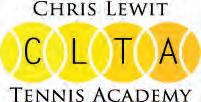


CourtSense Tennis Training Centers at Tenafly and Bogota Racquet Club 195 County Road l Tenafly, N.J. l (201) 366-2317 156 W. Main St. l Bogota, N.J. l (201) 366-2898
info@cour tsense.com

CourtSense offers the most up to date tennis facilities in Northern New Jersey and provides a comprehensive program of tennis instruction delivered by professional full-time coaches, using the finest techniques and technologies. With CourtSense, you’ll achieve your personal best, because our training is of the highest professional caliber—and easily tailored to suit your age and skill level. Children under 10 years of age benefit immensely from a proper training foundation—eliminating poor techniques that could limit their game later in life. We love helping juniors and adults achieve their goals on and off the tennis courts, and our ultimate goal is for everyone that steps into our facilities to learn something new while leaving with a smile on their face.
CourtSense Tennis Training Centers have a whole range of activities to support junior and adult tennis lovers. From red-ball tennis and afterschool clinics to high-performance full-day program including a partnership with the Dwight School and ICL Academy, Hit to Fit tennis, internal and USTA leagues, and private and group sessions, we have something to suit everyone. CourtSense students have access to 15 indoor tennis courts with new LED lighting, world-class strength and conditioning centers and luxury players’ lounges. The indoor facilities have also been updated with state-of-the-art UVGI systems that are constantly sanitizing the air inside the facilities and making sure that air is of the highest quality.
CourtSense’s club in Bogota, N.J. primarily specializes on the high-performance and tournament players. We have worked with players who have become ATP- and WTA-ranked players, U.S. Olympians, as well as many college scholarship athletes, and currently work with a few pro players that are improving their ATP and WTA ranking, and some of the top juniors in the Eastern Section. CourtSense’s high-performance coaches, in collaboration with its fitness staff, have developed a program that maximizes athletes’ strengths, both on and off the court. The goal is to use tennis as a vehicle to teach life lessons by tapping into the spirit of every player, with passion, expertise and character. We want our juniors to be the best tennis players they can possibly be, but at the same time, be prepared to be successful in anything they want to be once their tennis careers are over.
Another unique aspect to the CourtSense’s facilities is the fitness programming provided in partnership with Magnus – Sports Performance. Magnus’ team has the ability to assess, correct, enhance and reassess an athlete–giving you everything you need to compete at the best of one’s abilities. The Magnus Team has a long experience working with top tennis athletes, as well as pro level athletes in other sports as well. CourtSense members have access to cutting-edge strength and conditioning technology, private sessions, nutritional counseling and mental toughness training.



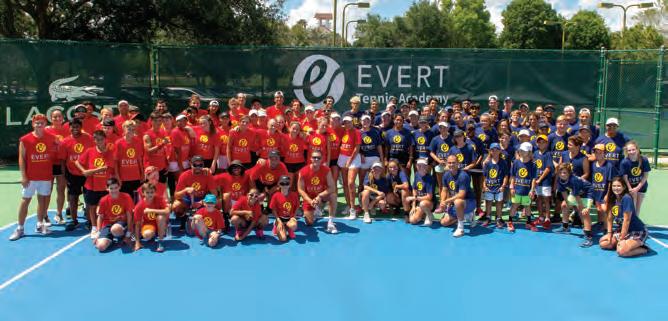
The Evert Tennis Academy (ETA) is located in the Mission Bay area of Boca Raton, Fla. With 23 courts, pristine grounds, state-of-the-art-equipment, a caring staff and family atmosphere combine to make ETA a beautiful and unique training environment.
As the proud home to more than 15 Grand Slam participants and over 100 Division I college athletes, the Evert Tennis Academy has a proven record of success in developing champions at the highest levels. Chris Evert, tennis legend and winner of 18 Grand Slam titles, and John Evert, world-renowned developmental coach and academy director, believe in designing personalized programs that consist of a strategic balance between technical, tactical, mental and physical training. They pride themselves on handpicking some of the finest developmental coaches working in the sport who are dedicated to the instruction, development and success of each athlete
The Academy Program at Evert systematically addresses every aspect of a player’s game through a daily regimen of technical, tactical, mental and physical training. The Morning Training Session is composed of drilling, and strength and conditioning. The program is continued in the afternoon with a focus towards competition and tactics. The Developmental Program at Evert Tennis Academy is designed to take players to the next level by providing a very exclusive, individualized program and the difference between it and the Academy Program lies within the daily 1:1 lesson. Boarding students ages 12 to 17 enrolled in the Full-Time, Weekly or Camp programs, stay in our on-campus three-story dormitory. Each dorm room houses up to two students during the school year and up to four students during Camp and Summer Sessions with boys and girls being housed in separate buildings.
Evert Tennis Academy conveniently provides one-on-one airport transportation for its boarding students, for a fee (subject to change), to all three area international airports: (PBI) West Palm Beach (35 minutes), (FLL) Fort Lauderdale (35 minutes), (MIA) Miami International (55 minutes).
All transportation coordination is handled directly through the Academy, making it stress-free and easy for you. Please contact Evert Tennis Academy at (561) 488- 2001 for more information or e-mail mateo.garces@EvertAcademy.com.



725 Exterior Street at East 152nd Street and the Harlem River Bronx, N.Y. l (718) 665-4684

Gotham Stadium NYC is located just minutes from Manhattan, several blocks south of Yankee Stadium at East 152nd Street and the Harlem River. This popular facility is quickly shaking its label as “the best-kept secret in New York City tennis,” featuring 16 cushioned, US Openstyle Deco-Turf hard courts, including 12 indoor courts, which are open for indoor play from October through April.
The “Gotham Stadium Bubble” continues to reign as one of the largest tennis bubbles or tennis domes of this type in the world, covering an area of more than four million cubic feet and a footprint of more than 75,000-square feet. The “Bubble” features high 65 ft indoor ceilings and spacious backcourts. These offerings please the playing public and aspiring junior players from throughout the metropolitan NYC region including beginners and advanced beginners, intermediate and advanced tournament level, interscholastic and collegiate players who train and compete at and call Stadium Tennis Center their “home court.”
Stadium Tennis Center also offers complimentary on-site parking to the north of the facility. The on-site Clubhouse will welcome you to host special events, birthday parties, and tennis gatherings for all of your family and friends, and the updated Pro Shop offers all your tennis necessities. The Clubhouse also features clean, secure locker rooms and lounge areas, Wi-Fi computer access, a workspace where children can do schoolwork and read.
This highly-touted facility offers a full complement of tennis programs for juniors and adults of all skill levels and ages. In partnership with Gotham Tennis Academy, a leader in developing and operating tennis programs in New York City and the Hamptons, Stadium Tennis Center employs high level, experienced tennis professionals from all over the world who have established a strong sense of ownership in the success of the total Stadium Team. Stadium’s Elite High Performance and Junior Development Programs including the Gotham Stadium NYC Summer Camp and the 10 & Under Junior Program are proven programs that get results in a fun, supportive atmosphere. For adult players, fast-paced group clinics, liveball and cardio tennis workouts are offered daily, in addition to indoor seasonal court rentals, private lessons, gamearranging, and leagues.
For more information about Stadium Tennis Center at Mill Pond Park, visit StadiumTennisNYC.com or call (718) 6654684.4684.




MatchPoint NYC is the sports and fitness destination for the entire family, located in Brooklyn, N.Y. only 20 minutes away from downtown Manhattan. Spread across 120,000-square-feet, MatchPoint’s premier health and fitness complex features a cutting-edge tennis facility that includes nine indoor tennis courts.
MatchPoint’s Tennis Coaching Team is led by Numrud Nino Muhatasov, co-founder and director of MatchPoint NYC (a former coach of top WTA and ATP players, former captain and number one singles and doubles player for the St. John’s University Tennis Team, Big East Conference Finalist and two-time Most Valuable Player), together with featured Coach Alona Bondarenko (Australian Open Doubles Champion in 2008, ranked in the top 20 in the world in singles and top five in the world in doubles) and Head Pro Alexander Demidenko (Davis Cup Team Member, head coach of the former USSR Girls National Team).
MatchPoint NYC’s world-class junior tournament training programs (by invitation only) are comprised of highly-ranked players on national and international levels. The club offers personalized coaching for each player, plus private lessons, intensive drills, match play, tennis-specific fitness conditioning and mental conditioning. MatchPoint has a wide range of programs for all levels, including adult leagues, QuickStart, Junior Development (beginner, intermediate, and advanced) and private lessons taught by accredited USPTA-certified coaches.
MatchPoint NYC’s WiFi-enabled Café is open for breakfast, lunch and dinner. Relax and unwind after a game, grab a bite to eat or relax while you watch your child on the court. Enjoy a healthy snack or get refreshed with a smoothie at the juice bar. Stop by the Pro Shop if you forgot something or if you need your racquet restrung. Free parking is also offered on premises.
Additional club features include a luxury full-sized gym, three group fitness studios, a Junior Olympic pool, a basketball court and a variety of youth and adult recreational and competitive training programs. MatchPoint NYC-certified instructors and personal trainers are friendly, approachable and ready to assist in your individual fitness objectives. The group swimming and exercise classes in Matchpoint’s specialized studios or outdoor field, health metrics assessments, and one-on-one training will get you the desired results in your quest for a healthier lifestyle.
Complete your day of health and fitness by winding down and relaxing in the steam sauna. Join MatchPoint NYC and FIND YOUR GAME!




Ross School Tennis Center (RSTC) is the premiere training center in the Hamptons, boasting a beautiful tennis facility that is open to the public and located on the Ross Upper School Campus in East Hampton, N.Y. The Tennis Center features six HarTru courts that are enclosed by a bubble from mid-fall through mid-spring, allowing for year-round play. The Tennis Center features state-of-the-art amenities such as spacious locker rooms, lower level lounge, convenient snack bar, and ping-pong tables, and the staff provides a fun and supportive atmosphere that allows for the greatest amount of success.
After-school programming, a dynamic program for junior players, and specialized summer programs are offered to make Ross Tennis Center the place to play tennis in the Hamptons.
• Nursery–Grade 4: Specialized one-hour training program where players build a strong foundation through a variety of game-based and cooperative activities using 10U age-appropriate (Red, Orange, or Green) balls and nets that will prepare them for eventual full-cour t play.
• Grade 5–Grade 12: Players build off their 10U foundation to further develop fundamental skills and techniques as they transition into yellow balls and prepare for full-cour t tournament competition. Ball control, strategy, and work ethic are all emphasized in this 90-minute session of drills and point play. Players in kindergarten and higher are required to play twice per week in this program.
• RSTC Yellow+ is for players over 12 years old who play either on a JV or Varsity school team. There will be practice ever y day for two hours after school. Tryouts can also be evaluated by an RSTA coach if you are not yet a team member. Participation at both UTR and USTA tournaments is encouraged but not a requirement.
• Lessons and Court Rentals: Ross School Tennis Center also offers adult clinics, court rentals, and private and group instruction for all ages and levels. The Tennis Center is also used for a variety of special events and is available for private parties.



Home of the John McEnroe Tennis Academy and the Johnny Mac Tennis Project 1 Randall’s Island l New York, N.Y. (212) 427-6150 l

SPORTIME Randall’s Island is the largest and best indoor tennis club and training facility in the world, featuring 29 climate-controlled, hard and softsurface courts, housed in buildings and bubbles. The club is the flagship location of the John McEnroe Tennis Academy (JMTA), named one of the top five academies in the Country.
SPORTIME Randall’s Island features more than 250,000 square feet of tennis courts and amenities, including 10 indoor and five indoor/outdoor Laykold tennis courts, 7 indoor HarTru soft-surface clay tennis courts, and 7 indoor/outdoor HarTru clay tennis courts that feature HiQ sub-irrigation technology. All indoor/outdoor courts, including a stadium court, are lighted at night when outdoors. This extraordinary club also features: a functional training and fitness center; comfortable lounge areas with excellent viewing; a pro shop featuring top brands and 24-hour stringing; spacious locker rooms; a café serving healthy food, snacks and beverages; and classrooms, flexible event spaces and meeting facilities.
In addition to tennis, SPORTIME Randall’s Island offers 6 beautiful, new dedicated Pickleball courts on which players of all ages and skill levels can learn, compete or just play for fun with friends. Program offerings include group instructional clinics, private instruction, social open play sessions and competitive tournaments throughout the year. Our NYC pickleball facility is also the ideal venue for pickleball events such as birthday parties, corporate outings and professional competitions.
In 2010, SPORTIME and New York tennis legend John McEnroe launched JMTA at SPORTIME Randall’s Island. The Academy is led by New York tennis legend Patrick McEnroe, assisted by SPORTIME’s Executive Director of Tennis, Mike Barrell, and joined by many other world-class directors. The athletic development and tennis coaching staff includes more than 60 experienced professionals from around the world, selected by the SPORTIME/JMTA leadership team.
SPORTIME/JMTA is proud to have developed hundreds of players who have received scholarships or favored admission to top colleges and universities through their tennis.
In addition to world-class green and yellow ball group training for top juniors, and juniors of all levels who want to reach their tennis potential, SPORTIME/JMTA offers a wide variety of programming for our younger, developing players, including SPORTIME Bounce for preschoolers, JMTA’s trademarked Mac Red Ball and Mac Orange Ball programs and more. SPORTIME also offers private tennis and athletic training, and the best group instructional and competitive programs and services in New York City for adult players, including game-arranging.
Also based at SPORTIME Randall’s Island is the Johnny Mac Tennis Project (JMTP), a 501(c)(3) organization, which, in partnership with SPORTIME, provides scholarships to motivated and deserving young players and introduces the sport of tennis as a lifelong health, fitness and social activity to thousands of under-resourced New York City area kids. JMTP’s mission is to change young lives by removing the economic and social barriers to success through tennis.





The USTA Billie Jean King National Tennis Center, home of the US Open Tennis Championships, is the largest public tennis facility in the world. It is, most certainly, a “Tennis Welcome Center.” The Tennis Center is open to the public year-round for court rentals and offers exciting programming, as well as numerous events throughout the year. Programs are offered for all ages and levels, as well as clinics, private lessons, leagues, tours, field trips, summer camps, corporate events, birthday parties, and tournaments. The NTC also supports all USTA Community Tennis and Player Development initiatives.
The professional staff of the USTA Billie Jean King National Tennis Center also conducts community tennis programs, including 11 & Under Tennis for children 11 years of age and under to learn tennis in a fun and dynamic way; USTA Junior Team Tennis for youth match play; USTA League Tennis for competitive, level-of-play competition, and an official Cardio Tennis site for on-court heart-pumping fitness.
There is an extensive summer camp program which provides basic tennis instruction starting as young as 11 and under up through and including Academy level players. Camps include instruction and fitness programs; the encouragement of good sportsmanship leading to general character building for the children of all ages and levels. These services are provided at a nominal cost, making it affordable for youngsters who would not otherwise get the chance to attend camp or receive tennis instruction. Lastly, the Project ACES (Alternative Classroom Environment for Students), implemented at the NTC in 2009, is geared towards children from schools from the New York City Metropolitan Area. This program provides students the opportunity to visit the NTC and learn about the history and the game of tennis. The kids are given a tour of the entire site, including Center Court in Ashe, a video presentation on the history of tennis and the great players of the sport, followed by an hour of on-court tennis instruction.



By Dr. Tom Ferraro
Everyone wants fame, glory and wealth. America is a culture that celebrates achievement which means we need to prove our worth and earn our status. We go about earning our station in life by winning trophies, getting scholarships to college, driving a new car, and living in a golden zip code neighborhood. Teenagers are just as caught up with this as adults. This used to be called the rat race and in 2024, it’s the only game in town. If we don’t get to the top, we enter the waste bin of society, filled with what society views as the losers.
And the world of tennis is not exempt from all this. What makes this issue more problematic is that the modern world is an entertaining place rife with a variety of distractions, opportunities and funfilled experiences that can get you off task and into the world of pleasure seeking.
So it’s no surprise that one of the biggest issues to emerge in the world of sports recently is mental health. When Naomi Osaka, Michael Phelps and Simone Biles all collapsed with anxiety, the world took notice. The result of this continuous pressure to succeed, which is in conflict with the world of distraction, pleasure and entertainment, is a new cultural syndrome characterized by restlessness, rushing, lack of focus, irritability, exhaustion and sleep deprivation. Let’s call this the “21st Century Syndrome.”
This is burnout on steroids. I would suggest that this new syndrome is even worse than burnout since we now have trainers, chiropractors, doctors, physical therapists and a variety of medicines to keep the athlete moving. I know
Dr. Gary Wadler, the noted sports medicine physician who does incredible behind the scenes work during the U.S. Open to keep his players moving.
Let us take a moment to assess how top figures in any field have made it to the top without succumbing to burnout, distractions, exhaustion, injury or depression. It seems that it would be impossible to avoid these conflicts. Everyone wants fame and everyone wants fun. How do the greats in any field do it?
1) Sports: One of the most famous athletes on earth is Tiger Woods. Tiger trained endlessly, ate a restricted diet and transformed golf into a sport of fit athletes. Tiger knew one thing only and that was golf. His fund of knowledge in other areas was extremely limited.
2) Literature: Henry David Thoreau, the transcendental writer became famous when he published Walden in 1854, a book that is considered to be one of the great pieces of American literature. Thoreau performed a social experiment by living in a little shack in the woods for two years, two months and two days. He was cut off from human society and kept a journal of his two years in nature. This book became America’s most important treatise on how to live simply and in solitude, with selfreliance and as a part of mother nature. This social experiment is closely aligned with ancient stoicism as well as with Buddhism.
3) Dance: Paul Taylor, was one of America’s most famous and wellknown choreographers. Taylor did only one thing which was to
choreograph dances. When Christmas came along each year, Paul Taylor was shocked and angered that his dance troop decided to go home for Christmas since this meant he would not be able to work that week.
4) Art: Norman Rockwell was the famed illustrator that did all those Saturday Evening Post magazine covers and his popular, family oriented and wholesome images of Americans helped define our national identity. But in reality he worked every day of the year including Christmas. One Christmas morning his wife entered his studio and pleaded with him, “Norman, please join us for Christmas dinner this year”, to which he retorted “But I’m under a deadline to finish this painting.”
5) Music: Jimmy Hendrix is known as one of the world’s greatest guitarists. I was lucky enough to see one of his concerts in the late 1960s and also got to meet him backstage. The sound he made on stage almost knocked you over is was so masterful and loud. And meeting him in person was another revelation. He was odd, shy and almost schizoid in character. He was better suited to being on stage with a guitar rather than backstage talking to people.
All of these exemplars of fame, fortune and mastery of their craft demonstrate what we call in psychoanalysis asceticism. The defense of asceticism is the elimination of pleasurable pursuits in an effort to achieve pride and efficacy by renouncing things. The word asceticism derives from the

monks, world renowned athletes and super stars in any field are models of the ascetic lifestyle. They have immersed themselves in their field to the exclusion of all other things. They have successfully renounced the distraction of pleasure to achieve their dream of transcendence, be that spiritually, intellectual, athletic or aesthetic.
In high school we were all forced to read the epic poem, “The Iliad” by Homer. At the beginning of this story Achilles, who is on the verge of becoming a great warrior, must decide whether he will go to war against the Trojans. He asks his mother, the goddess Thetis, to help him decide what to do. She tells him this: “My son, all men must choose between one of two paths in life. One path leads to the battle field
where they will obtain fame, glory and immortality but they will lead short lives and die young. The other path is to remain in your homeland take a wife, raise a family, have many friends and live a long life. You must decide which of the two paths you want. I cannot decide this for you.” Achilles chose the former path and we still know his name do we not?
The reality is you can’t have it both ways and you can’t have it all. Just like young Achilles, we all must choose between one of these two paths. One is the one less traveled and it may lead to fame and fortune, but usually it is a lonely path and difficult path to travel. This is the path that monks and saints and


super star athletes have been on. They have renounced the simple life and they have renounce many of the small pleasures of life like free time, getting up late and eating cake. This is the ascetic life and this road is taken by the pathfinders, the pioneers and the game changers. The other path is more frequently traveled. It is the life of leisure and fun, pleasure and friendships galore. That is by far the easier life to live. I am not sure which one is right for you but what I do know for certain is that you can’t have it both ways. Like Achilles, you either go to war and seek out fame or stay home and live a long and easy life. It’s up to you, your passion, your talent and your ability to choose wisely.
















Headinginto this season, the Abraham Lincoln Railsplitters were a motivated bunch. After being defaulted in the playoffs in 2023, the team was determined to prove itself this fall.
The girls from Lincoln proved it belonged the city’s best, and captured the PSAL New York City 1A Championship, edging out the High School for Environmental Studies Eagles in a 3-2 comeback on the indoor courts at the Queens College Tennis Center.

“I promised myself and these girls that we would come back this season and dominate the division to get what we felt we deserved,” said Lincoln head coach Vincent Garcia. “We absolutely could not wait to get the team together this year, and we fought hard and we did it.”
Garcia’s team would have to fight hard in the championship match, especially after Environmental Studies won two of the final’s first three flights to move within one court of the title.
First, Lian Wacspress won 6-0, 6-0 at second singles to give the Eagles the early advantage. Soon after, Lincoln responded thanks to a 1-6, 6-2, [10-5] come-from-behind victory from Katelynn Espinosa at third singles to even the match at 1-1.
But Environmental Studies would win first doubles, a 6-3, 6-3 victory from Catherine McIntyre-Polner & Shay Fairweather, and needed one of the final two remaining courts to clinch the city title.

But as it had vowed to do from the beginning of the season, the Railsplitters continued to fight, specifically Deandra Smith who found herself in a battle at first singles. The senior was up a set, and began to feel sick during the second set when she had to take a medical timeout.
“Deandra knew what was on the line during her match. As a senior, she knew that her situation to be a city champion was now or never,” said Garcia. “I wanted her to use the full 15 minutes to be sure that she was more than ready to return, which she was. She never gives up, and knows the match is not over until the last point. Her presence and attitude sets a great example for all the other girls on the team and I’m glad they could witness that.”
And her teammates had a front row seat to Smith demonstrating that. She returned to the court and while she would lose the second set, was recharged for the ensuing decisive super tiebreaker. Smith used her big lefty forehand to dictate the play and secured the win in the tiebreaker, winning the first singles court for the Railsplitters and leaving the city title to be determined by second doubles.
With the championship on the line, and the eyes of players, coaches and supporters of both teams looking on, Jazell David & Shayna Weekes held their nerve, winning 6-3, 7-5 to win second doubles, and clinch the title for Lincoln.
“I am extremely proud of the resilience and calm composure that both Jazell and Shayna showed in such a high-pressure situation,” said Garcia. “In a typical match during the season most matches are played simultaneously, so it isn’t common for many spectators to be as engaged on what court as they were on that day. The fact that they were able to lock in and get the job done was remarkable to watch. During changeovers, I just kept reminding them that they were in control of the match and to keep fighting to stay on top.”
Lincoln concludes its season on an 11-match winning streak and brings home the program’s first-ever tennis championship.
Party like its 1978.
The Lady Knights of James Madison captured the PSAL New York City 2A Girls’ Tennis Championship this fall, defeating McKee/Staten Island Tech 3-2 in a thrilling finals match, and bringing a city title back to James Madison for the first time in nearly 50 years.

“I’m so proud of the team and grateful and honored to be a part of the journey,” said James Madison head coach Matthew Nanes. “We’re calling it ‘A Season to Remember’.”
And that journey actually began during last year’s playoffs, after a tough defeat in the semifinals. Nanes can remember the pain of that loss and the motivation he saw in his player’s eyes, and the Lady Knights vowed to come back stronger in 2024.
“The disappointment on the bus ride home was enough to accept the mission of next season,” he recalls. “We actually lost one of our top players, but luckily we added two talented freshmen, Milana Markov at third singles, and Sofia Vinnik at first doubles, and at that point I knew that with our hungry veteran players and new young talent, we would have a great shot at making a run.”
The team made good on that commitment, going through the regular season undefeated and earning the top-seed in the playoffs, making its way into the championship match against the Seagulls.
up with a new strategy. Being able to stay focused and calm enabled us to dominate the second set and tiebreaker which set us up for an opportunity for team victory.”
With four courts done, the city championship would come down to the second doubles court.
“I always joke about a nice easy low-stress 5-0 win, but this team seems to always want to make it interesting,” said Nanes.
James Madison’s Angela Wu & Irma Gaidukova jumped out to the early lead as they won the first set 6-4, only to see their opponents respond with a 7-5 victory in the second set, bringing the deciding second doubles court to a 10-point super tiebreaker.

The aforementioned Markov won at third singles in the championship match, posting a 6-1, 6-1 victory, while the Seagulls got a key victory from the first doubles tandem of Alina Pokhylko & Dominika Schutz who won 6-4, 6-4, tying the overall match at 1-1.
Priyanka Shah of McKee/Staten Island Tech held on to win 7-5, 3-6, [10-5] at first singles, and on the next court over, Nicoletta Draganchyuk came back from a set down to win 57, 6-0, [10-1] for James Madison at second singles, which was a crucial win for the Lady Knights’ path to victory.
“I knew that if we had a realistic chance at victory, we needed a win in that spot,” said Nanes. “After dropping the first set, there was a need to assess the situation and come
In the ensuing tiebreaker, Wu & Gaidukova were able to rise to the occasion, winning six of the final seven points from 4-4 to win 10-5, sealing their win and clinching the city title for the Lady Knights.
“The ability to remain calm when we are down and bounce back to some thrilling victory is the common thread for most of the squad,” said Nanes.
The victory is James Madison’s first tennis championship in nearly a halfcentury, and it’ll be a longtime before these players and the school will forget this season.
“Over the last 20 years I have had the privilege of coaching some great student-athletes, and while each group had its own memorable events, this year there was just something different,” said Nanes. “There was talent but something much more than that. Carrying 20 girls on the team with only seven playing regularly in matches seems like a recipe for disaster, however, the support for the team as a whole and camaraderie was admirable. If you weren’t on the court, you were cheering and encouraging your teammates. The entire squad earned and deserved the title of City Champions, and it will be nice to have ‘2024’ printed along with ‘1978’ listed on the banner hanging in the gymnasium.”
2024 new york girls’ high school recap continued from page 00
ThePSAL Individual Championships were held at Queens College. Below are the results:
• Singles Champion: Mariia Vainshtein (James Madison)
• Doubles Champions: Nicoletta Draganchyuk & Alexis Goodman (James Madison)

1) Mariia Vainshtein (James Madison)
2) Priyanka Shah (McKee/Staten Island Tech)
3) Elizabeth Sabaev (Townsend Harris)

1) Nicoletta Draganchyuk & Alexis Goodman (James Madison)
2) Anusha Yadav & Isabella Djokic (Francis Lewis)
3) Nicole Soltsov & Alina Pokhylko (McKee/Staten Island Tech)
sports cliché is that you can learn more from your losses than you do from your wins.
While that may not always be true, it was for the doubles tandem of Michelle Rosenblit & Alison Tsai of Horace Greeley. The pairing lost in the doubles finals at Sectionals, but were still able to qualify for the New York State Public High School Athletic Association (NYSPHSAA) Individual Championships.
“We knew we needed to forget about Sectionals and move on to States, this is more important,” said Rosenblit. “We were happy that we had the chance to redeem ourselves.”

And redeem themselves they did. After winning their first three matches at States, Rosenblit & Tsai faced off against the same team that beat them in the Sectional final: Byram Hills’ Jenna Kleynerman and Katherine Shil.
This time, the Horace Greeley duo would come out on top, winning 6-4, 7-5 to move into the finals and a matchup with the top-seeded pairing of Gabrielle Villegas & Madison Lee of Great Neck South.
They delivered a dominant performance in the final, racing out to an early lead and never looking back, winning 6-1, 6-1 to claim the New York State doubles title.
“We came in here with a fresh mind, forgot about everything that happened before and stayed in the present,” said Tsai. “I’m lucky to have Michelle as a partner, we’ve known each other for so many years, and we have a sister-like bond that helps us communicate together on court.”
Below are the top 8 finishers at the NYSPHSAA Doubles Championships:
1) Michelle Rosenblit & Alison Tsai (Horace Greeley)
2) Gabrielle Villegas & Madison Lee (Great Neck South)
3) Jenna Kleynerman & Katherine Shil (Byram Hills)
4) Kay Cottrell & Isabel Lin (Scarsdale)
5) Chloe Gross & Alexandra Krol (Roslyn)
6) Ava Borusso & Matilda Buchen (Westhampton Beach)
7) Lydia Koivula & Samantha Ostrander (Burnt Hills-Ballston Lake)
8) Emilia Romano & Evie Romano (Bayport-Blue Point)
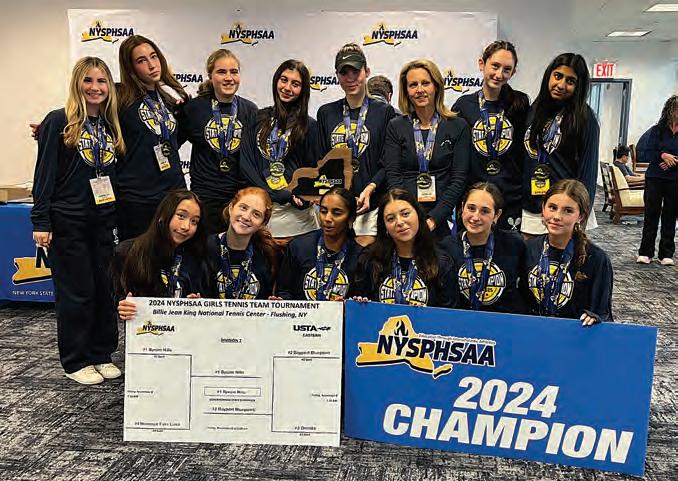
Forthe third time in four years, the girls from Byram Hills are the New York State Division II (Small School) Champions.
The Bobcats brought the state title back to their school with a 4-1 triumph over Bayport-Blue Point at the USTA Billie Jean King National Tennis Center last winter.
The title was clinched by the first doubles tandem of Katherine Shil & Emerson Pace, who won 6-3, 6-2.


“It’s so amazing, and such a privilege to be a part of this school and this team. It was an honor to compete on these courts,” said Shil. “This was the toughest match we’ve played together, and there was a little drama during the match, but we used that as motivation, had fun and were able to pull through.”
Pace added:
“After not winning last year, we wanted to come back, and to be able to win it again is the best feeling. We lost in the Sectional finals a year ago which definitely fueled us this season.”
Byram Hills got a first singles victory from Jenna Kleynerman, who held on to win 6-3, 3-6, 6-2. At second doubles, Dani Goldman & Jordyn Bernstein were 6-1, 7-5 winners, while the third doubles tandem of Eliza Moy & Anisha Bobra won 6-3, 6-4.
Lily Castka secured the lone victory for BayportBlue Point as she won 6-1, 6-1 at second singles.
“Individually, these girls were fantastic, but as a team they were unstoppable,” Byram Hills head coach Jessica Kaplan said. “Their teamwork is what got them the prize.”
2024 new york girls’ high school recap continued from page 00
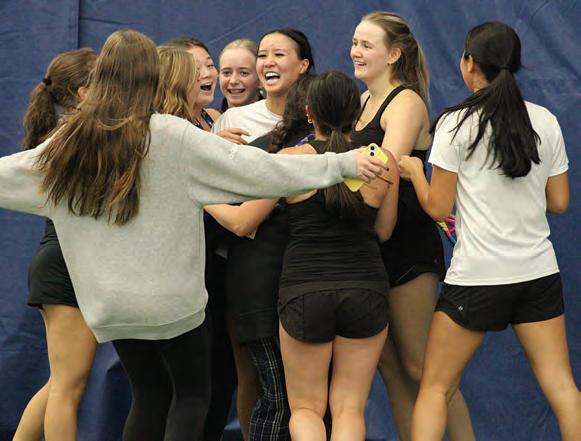
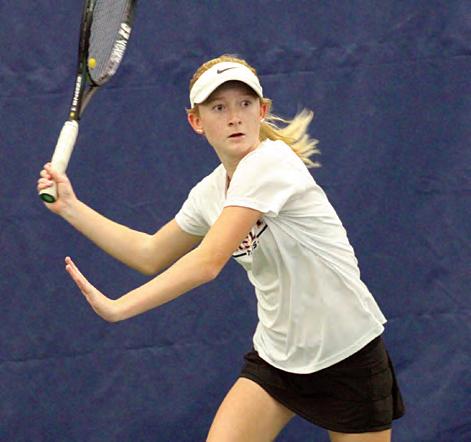
TheQuakers of Horace Greeley defeated Syosset to win the New York State Division I (Large School) Championship, winning five of the seven courts at the USTA Billie Jean King National Tennis Center to bring home the program’s first state title.
Daniella Rosenblit got her team started with a 6-0, 6-0 victory at third singles, while Meadow Zhang & Scarlett Mcfadzen posted a 6-3, 6-1 win at first doubles.
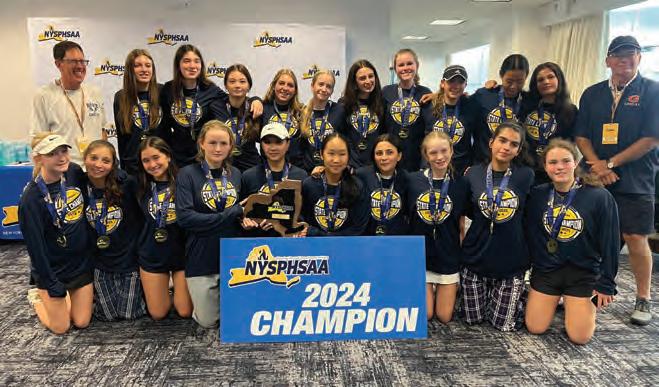
match to clinch it.” Tsai, the senior captain, would seal her team’s title 6-3, 7-5 win at second singles.
At second doubles, Isla Gibb & Sadie Mcfadzen were 6-3, 6-4 winners and from there the Quakers needed just one win to clinch the state title.
“I was trying to focus in as much as I could. I knew if my eyes started to wander, then I would have lost focus,” said Alison Tsai, who was playing second singles for Horace Greeley. “I wasn’t aware that we had already won three matches, but it feels great knowing I was the
“It feels like a full circle moment,” Tsai reflected. “I have been on this team for four years, and the last three we never even won Sectionals let alone made it here. So it feels good to be able to win this knowing it’s my last year. I just wanted to give it my all in my last high school match. From the moment I stepped on the court, I wanted to play my game and play to win. I couldn’t ask for anything more to close out my career this way.”
To round out the scoring for Horace Greeley, Lia Yedid & Sophia Wang won 7-6(2), 6-1 at third doubles.
For Syosset, the fourth doubles tandem of Kayla Lo & Manasi Pradhan won 6-3, 6-4, while Stephanie Marcheret held on to win 6-4, 6-7(4) [10-4] at first singles.

To play tennis at a high level you need to have the capacity to both “make time” and “take time.” Understanding this principle, players need to be developed to have the skills to both read the opponent and recognize the incoming ball from the very beginning of their development. It is also important not just to play the ball well, but also be able to position themselves and hit the shots necessary to set themselves up to build “winning opportunities.” The concept of Receive-Send-Reposition we call the Player Conversation, and it’s imperative to developing high level tennis players.
In 12 and under tennis, players often win tennis matches by outlasting their opponents. Shots are hit with a primary focus of keeping the ball in play rather than developing the point and looking for opportunities to take advantage and challenge their opponents. This becomes a problem as players get older and the level of consistency is very high across the board.
By allowing younger players to spend longer periods using ROG (Red, Orange, & Green Balls) with smaller courts and slower tennis balls, players will have an opportunity to reach an entirely different level of development and understanding of the game, while
By Ray Josephs


also developing the ability not just to develop greater technical proficiency, but also, to create offensive opportunities by becoming comfortable playing from all locations in the court, both on the 60-foot court, and full court as well.
By allowing players to train longer with smaller courts and slower balls they will have the opportunity to not just become proficient in rallying from the baseline and keeping the ball in play, they can learn all different shot varieties and modes of play.
Players trying to manage yellow balls from the full baseline at a young age will often lean on looping and lobbing the ball and playing more defensive and neutral modes of play. Players that may be skilled enough to play yellow or green ball but decide to spend more time with orange or green will have the opportunity to develop taking the ball early, on the rise, and attacking and challenging their opponents with penetrating drive shots and swing volleys. With the balls being slower and having more time to play the shots, they will also learn to hit slice backhands and drop shots with purpose.
The drive to win almost always takes over in a young player's mind when they step from the practice court to competition, by staying longer in smaller courts and progression balls, players will have the opportunity to both be successful and also develop skills in their games that will separate them from their peers as they progress through the ranks.

Ray Josephs is Director of Coaching and Player Development at CourtSense at Tenafly Racquet Club. Ray maintained a high national ranking throughout the juniors as well as an impressive high school and college record. A few years ago, Ray spent his time training numerous highly ranked national and international juniors at the Rick Macci Tennis Academy in South Florida. Before that he was the primary coach for many top 20 juniors, as well as players on the WTA tour. Ray has been part of the CourtSense team for 12 years and counting.


Preparingfor a tennis tournament requires careful planning, discipline, and focus. However, even the most experienced players can fall into common pitfalls that negatively affect their performance. Here are some of the top mistakes to avoid when getting ready for a tennis tournament:
Tennis is a physically demanding sport. Although match and mental preparation are essential, adding extra hours of fitness training, focused on strength and endurance, can negatively impact performance. This excessive training can lead to feelings of overtraining and fatigue.
Tip: During the week before a tournament, you can work on reaction, agility, speed, and flexibility. However, avoid long and intense practices. Instead, reduce your time on fitness compared to your regular routine, which you can allocate to the weeks when you don’t have a tournament.
Practice matches simulate tournament conditions and help you get accustomed to competitive pressure. Skipping these matches
By Dejan Vukojicic
can leave you unprepared for the mental and physical demands of actual competition.
Tip: Schedule several practice matches against opponents of varying skill levels to refine your strategies and adaptability. Being confident against players of all levels will help you to approach matches in a prepared and focused manner.
Many players overlook the role of proper nutrition and hydration in maintaining energy and focus. Consuming the wrong food or not drinking enough water can lead to fatigue, cramps, and poor decisionmaking on the court.
Tip: Follow a balanced diet rich in carbohydrates, proteins, and healthy fats. Stay hydrated throughout the day, especially in the hours leading up the to the match, and consider electrolyte-rich drinks during practice and matches.
Tennis is as much a mental game as it is a physical one. Neglecting mental preparation can lead to stress, lack of focus, and poor performance under pressure.
Tip: Practicing visualization techniques, mindfulness, reset techniques, and positive self-talk
should not just be something you do in matches but something you practice all the time to ensure that it comes naturally to you when match time comes.
While consistent practice is crucial, overtraining can lead to burnout and injuries. Many players feel the need to cram excessive practice sessions just before a tournament, which can backfire. You need to ensure that you approach a match feeling high-energy.
Tip: Maintain a balanced training schedule and include rest days to allow your body to recover. Reduce the intensity and hours on the court of your training a few days before the tournament.
Switching to new racquets, shoes, or strings shortly before a tournament can disrupt your game. Unfamiliar equipment or strings may feel strange and affect your performance. Equally, new shoes and clothes may look great but may not fit well and cause discomfort.
Tip: Use familiar equipment and test new gear well before the tournament.
Going into a match without a game

plan can lead to aimless play and frustration. Many players fail to analyze their own strengths and weaknesses or those of their opponents.
Tip: Work with your coach to develop strategies tailored to your playing style and potential opponents. Review past performances to identify areas for improvement.
Recovery is just as important as training. Neglecting post-practice recovery routines can lead to muscle soreness and fatigue, and in a tournament that can mean not being ready for your next match.
Tip: Include stretching, foam rolling, and proper rest in your routine. Depending on your level you might also want to consider sports massages and ice baths for enhanced recovery.
Knowledge about your opponents can
provide a significant advantage. Many players skip this step, entering matches blind. Scouting doesn’t mean just checking on a player's UTR level but watching them play and talking to others.
Tip: Observe your opponents in practice or review videos of their matches. Take note of their playing style, strengths, and weaknesses. Instead of UTR level, focus on his style. You have general tactics against different styles of players and start to create your game plan around that.
Showing up without essentials such as

two, three, or more of the same racquets, water bottles, electrolytes, snacks, towels, or backup equipment can add unnecessary stress.
Tip: Pack a tournament bag the night before, including all essentials, and double-check it in the morning. Arrive early to acclimate to the venue and warm up properly.
By avoiding these common mistakes, you can enhance your preparation and boost your chances of success. Remember, preparation is not just about hard work but also about working smart and staying balanced.


















Thebeginning of a New Year is always exciting. People make resolutions and commit to bettering themselves, and for the world’s top tennis players, a fresh start and a blank slate presents itself as a new season begins.
And that new season begins in the land down under at the Australian Open, the first of the tour’s four majors. Last year’s event played host to a new champion on the men’s side and a repeat champion on the women’s side, with Italy’s Jannik Sinner capturing the first major of his career, while Belarus’ Aryna Sabalenka defended her 2023 title.
To preview the 2025 Australian Open, Long Island Tennis Magazine examined the contenders, pretenders and sleepers for the Men’s Singles and Women’s Singles events:
Jannik Sinner
The current world number one had one of the best seasons in recent memory in 2024, and it all began at the Australian Open for the Italian. In a remarkable run, he knocked off Novak Djokovic, who had not lost in Melbourne since 2018, in the semifinals before coming back from two-sets-to-love down against Daniil Medvedev in the finals. That triumph kicked off a year where Sinner would win 73 matches, losing just six, and won eight titles, including the U.S. Open, the ATP Finals in his home country of Italy, and leading his nation to its second consecutive Davis Cup title. Sinner is the betting favorite to repeat as Australian Open champion.
Tommy Paul

2024 was an exciting year of tennis and especially so for the Americans, with Tommy Paul being a crucial part of the success on the men’s side. Paul won three titles last year and finished the season ranked 12th in the world, his career-high ranking, and begins the new year in a spot where he has found success before. The lone major semifinal of his career was at the Australian Open, in 2023, and he will look to build on that at this year’s Aussie Open. Paul is one of the most
athletic players on tour and has shown he is capable of beating the best players in the world, with wins over Sinner, Carlos Alcaraz, Novak Djokovic and Daniil Medvedev, among others, which makes him a threat to win the title Down Under in 2025.
Novak Djokovic
The most dominant player in Australian Open history returns to the site where he has lifted 10 titles in his career, and coming off of a rather unsuccessful season, by his standards, is eager to reclaim his throne. When Novak Djokovic has been asked over the last couple of years how he remains motivated with all he has achieved over, he has been clear: winning majors. That is what keeps him going, and he plans his scheduling and training around that desire. With Andy Murray joining his coaching team, and a restful end to 2024, Djokovic could be fresher than he has been in recent years to begin a season. The key will be can his 37-year-old body hold up over the course of a two-week Grand Slam event, especially when most of his opponents are a decade younger than he is. But if anyone can do it, it’s Djokovic, and the Australian Open has been the major where he has found the most success over the courts of his career.
Carlos Alcaraz
There is no disputing Carlos Alcaraz status among the world’s best, however, there is one thing missing from his resume, and that is an Australian Open title. It’s the one major that Alcaraz has not yet won, and the Spaniard has never made it out of the quarterfinals Down Under. Other than that one quarterfinal result, Alcaraz has been eliminated in the second round and the third round in his other trips to the Aussie Open. While he is the No. 3 player in the world, and has the second shortest odds to win the event, he has not yet proven he can lift the trophy in Melbourne.

Casper Ruud enjoyed a return to form in 2024 following an injury-rattled season the year prior, and the Norwegian finished the year as the sixth ranked player in the world. He won 51 matches and reached the semifinals of the French Open, a place where he reached the finals the previous two seasons. But his lack of success on hard courts continued, which included a third-round exit at the Australian Open to begin the year and a fourth-round exit at the U.S. Open in September. Before he won a couple of round-robin matches at the ATP Finals, Ruud had lost seven of eight hardcourt matches at the end of the season, a slump that could continue in the new year. Ruud has never made it past the fourth-

round in Melbourne, and with his struggles on hard court still persisting, that may continue at the 2025 Australian Open.
Andrey Rublev
If you have ever played video games, you know how frustrating it is when you reach a level that you just can’t beat and get past. No matter what you do, it seems like you are doing something wrong or there is something you just aren’t able to figure out. That’s what it feels like with Andrey Rublev and major quarterfinals. He has reached that stage 10 times in his career and has been in the final eight at all four of the majors, but he has not been able to move past that point and play in a semifinal. Rublev has been mainstay in the Top 10 for years and currently sits at eighth in the world; but until Rublev shows he has figured out how to beat the quarterfinal level, he won’t be considered a serious contender to win a major title.
Jack Draper

It was a breakthrough year for Jack Draper of Great Britain, one he aims to use as a stepping stone entering 2025. Draper won two titles and posted a record of 39-22, finishing the season with a careerhigh ranking of 15th in the world. He really came into his own in the second half of the year which was highlighted by a run to the U.S. Open semifinals before he lost to the eventual champion Sinner. Draper followed that up with a title in Vienna, and had multiple wins over Top 10 players in the latter stages of the year. While his previous two trips to Melbourne did not yield great results, after proving he can make a deep run at a major with his performance in New York, Draper is a threat to do the same Down Under.
Jakub Mensik
The youngest player inside the Top 50 is Jakub Mensik of the Czech Republic. Still just a teenager, Mensik burst onto the scene in 2024, winning 25 tour-level matches after entering the year with just three tour-level victories in his career. He has a massive serve and plays extremely aggressively from the baseline, and thrives on putting pressure on his opponents. Mensik has the style of play that is built for the hard-courts, and two years ago, he reached the finals of the 2022 Australian Open junior singles final. At last year’s U.S. Open, Mensik won two matches to reach the third-round, and with a year of professional tennis under his belt, the Australian Open could be his coming out party on the international stage.
Alexei Popyrin
The last time an Australian man won the Australian Open? Mark Edmondson in 1976. Could that change in 2025? The Aussies have three men ranked inside the Top 26, with Alexei Popyrin being one of those three and checking in at 24th in the world. The big-serving Popyrin powered his way into the U.S. Open fourth round a year ago which was highlighted by a win over defending champion Novak Djokovic. Popyrin has the game to upend anyone on hard courts and he demonstrated that fact in New York last year. With the Aussie crowd getting behind him, Popyrin will have home-court advantage in his matches, and if he can channel the consistency he had at the U.S. Open, could be due for a big run in his home country.
Aryna Sabalenka
Belarus’ Aryna Sabalenka will arrive in Australia as the twotime defending Australian Open champion and will be in pursuit of a third consecutive title, something that has not been done on the women’s side since Martina Hingis in the late 1990s. Sabalenka established herself as the best player in the world in 2024 and is firmly entrenched atop the WTA Rankings. She bookended her season last year with the U.S. Open title to add a third major to her resume, and is the favorite to win her fourth to kick off 2025.
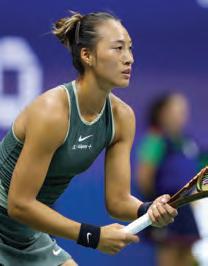
2024 was the best season of Zheng’s career and it sets up what could be an even bigger one this year. Zheng was the runner-up at the Australian Open, losing to Sabalenka in the finals, and while she did not compile great results at the French Open or Wimbledon, still had a successful summer. Zheng captured the Olympic Gold Medal in Paris, becoming the first Asian player to win an Olympic Gold Medal in a singles event. At the U.S. Open, she reached the quarterfinals for the second straight season before falling to Sabalenka once again, and made a run to the WTA Finals championship match to wrap up her season. Another deep run at the Australian Open could be in the cards for Zheng.
While the young American was unable to repeat as the U.S. Open champion last year, Coco Gauff still finished her year in a strong manner. Gauff won the WTA Finals in Saudi Arabia in a thrilling three-set match over Qinwen Zheng, and

concluded the season as the third-ranked player in the world. Gauff has continued to make strides to fine-tune her game, which includes shoring up her forehand and ridding her service games of double-faults, and the more consistent she gets, the more dangerous it is for her competition. Gauff reached the semifinals at the Australian Open in 2024, and has her sights set on returning to that spot and hopefully beyond at this year’s installment of the tournament.
Jasmine Paolini

The 28-year-old Jasmine Paolini was a revelation in 2024. She began the season ranked 29th in the world and had never made it past the second round at any of the four majors. But that quickly changed as Paolini put together the best year of her career, reaching the finals of both the French Open and Wimbledon, and concluded the year as the fourth-ranked player in the world. While she was great last year, it could just be a flash in the pan. Before reaching the fourth round in Melbourne last year, she had never won a match at the event. Paolini will have to show she is ready to back up her 2024 season before being considered a contender.
Iga Swiatek
While the aforementioned Paolini enjoyed the best year of her career, 2024 was a strange year for Poland’s Iga Swiatek. Yes, she did repeat as the French Open champion, winning the event for the third consecutive time, but did not find much success at the other three majors. That was coupled by the fact that she was handed a one-month suspension by the Tennis Anti-Doping Programme for a test that she had failed back in August. The Australian Open has never been Swiatek’s best major and she has lost in Melbourne in the third-round and fourth-round, respectively, the last two seasons. When you factor that alongside this recent suspension, Swiatek could be set up for an early exit at the year’s first major.
Daria Kasatkina
The ninth-ranked player in the world Daria Kasatkina is been a consistent player atop the WTA Rankings, yet has been unable to translate that into meaningful success at the majors. Each of the last two seasons, Kasatkina did not make it out of the fourth round out at any of the majors, and in her career, she has never advanced past the third-round at the Australian Open. Kasatkina has a crafty game that utilizes a lot of variety, which makes her a difficult opponent on clay and grass surfaces, but does not have the same power as some of
the other women inside the Top 10. While Kasatkina is one of the more consistent players on tour, her struggles at the Australian Open could continue in 2025.
Donna Vekic
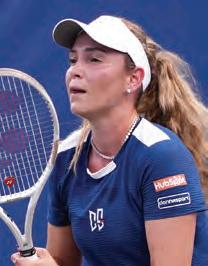
At the Paris Olympics last summer, Donna Vekic became the first woman from her native Croatia to reach even the medal stage, before winning her semifinal match and ultimately earning the Silver Medal. That result came on the heels of a run to the Wimbledon semifinals, and it proved to be one of the best summers of Vekic’s career. Vekic had ambitions of making a deep U.S. Open run, but ran into Qinwen Zheng in the fourth round, falling in a hard-fought three-set match. Vekic has reached the quarterfinals at the Australian Open before, in 2023, and brought in Sascha Bajin to be her new coach heading into the new season. Bajin was previously the hitting partner for Serena Williams during some of her dominant years, and coached Naomi Osaka while she was winning two of her Grand Slam titles, and Vekic hopes he can have a similar effect on her results in 2025.
Madison Keys
When the American arrives in Melbourne it will make the 10th anniversary of her surprise run to the Australian Open semifinals. Keys was just 19 at the time and shocked everyone by reaching the final four. While injuries have slowed her down in recent years, Keys has refound the form that made her a top player in the world, and she is a dark horse to make another deep run at the year’s first major. Few players possess more power than Keys from the baseline, and she has demonstrated the ability to go deep into the Grand Slams, evidenced by two Australian Open semifinals, a Wimbledon semifinal, and a U.S. Open runner-up finish. If Keys is healthy, look for her to potentially be one of the last women standing.
Leylah Fernandez
It seems like a lifetime ago that Leylah Fernandez came out of nowhere to reach the finals of the U.S. Open in 2021. Since then, the road has been a bit bumpy for the left-handed Canadian who now finds herself ranked 31st in the world, but 2025 could be a springboard to the next stage of her career. Fernandez won seven of her final 10 matches of the season so she should be feeling good about her tennis as we head into the new year. She has shown she is capable of making a deep run at the majors, with also a Wimbledon quarterfinal result to her name, and could be a sneaky pick to make the second week at the Australian Open.
By Chris Lewit
New release is now available on Amazon!
Themuch anticipated follow-up to Chris Lewit’s The Secrets of Spanish Tennis is now here! Released last month, The Secrets of Spanish 2.0 is a comprehensive update to Lewit’s initial release 10 years ago, featuring 45 Spanish tennis drills with detailed explanations that are supplemented by videos on Lewit’s YouTube channel (YouTube.com/chrislewit).
The book features forewords by legendary Spanish coaches Emilio Sanchez and Luis Bruguera, and this edition also includes a new chapter on Toni Nadal and other famous Spanish tennis coaches, a new chapter on the rise of Carlos Alcaraz, and an updated chapter detailing the top Spanish academies.
“Spain has dominated the world rankings on the ATP tour for many decades, a phenomenal accomplishment for such a small country,” says Lewit. “Spain is now positioned as the leading destination in the world for serious tennis players looking to train for the elite junior and professional tours.”

Over the course of 20 years and dozens of study trips, Lewit visited the leading Spanish academies and studied and interviewed some of the most legendary coaches in Spain to discern and distill their unique and special training

methodology. Now you can learn the Spanish way of training and use it to make yourself, your kids, or your students better!
Chris Lewit is a former #1 for Cornell and pro circuit player, bestselling author, educator, and one of the top junior coaches in the United States. He is a contributing editor for TennisPlayer magazine, Long Island Tennis Magazine, New York Tennis Magazine and the author of The Tennis Technique Bible. Born and raised in New York City, he now splits his time between New York City and Manchester, Vermont. He develops players in the NYC area and also at his high performance tennis training center in Manchester, Vermont.

The book is available in paperback on Amazon and in bookstores, and makes a great gift for the tennis fan in your life this holiday season!
By Rob Polishook
In full disclosure, this series of articles for 2025 will focus on pickleball. Now, please don’t stop reading because you are a triedand-true tennis player. Rather, recognize the similarities of all racket sports. On an applied level, there is much to learn from other sports which require a racket or paddle. And from a mental perspective the similarities also far outweigh the differences. I play tennis, pickleball, beach tennis and table tennis. I learn from each sport and always apply bits and pieces to the other. In short, any racket sport is connected by the Spirit of the Swing!

legend Roger Federer come to mind. These players inspire everyone around them; they never seem concerned with what they cannot control, whether it’s a bad call, a raucous environment in a rival stadium, or a particularly aggressive opponent. They play in the moment and compete with purpose, persistence, and patience, while also showing respect for their opponents, the game, and themselves.
Ask any athlete how important the mental game is, and most would say it’s between 50 percent and 99 percent of competition. In individual sports like pickleball, tennis, running and swimming, the value always pushes the higher limits. In team sports like baseball, basketball, lacrosse and football, it also has great relevance.
Remember Yogi Berra’s famous and funny quote, “Baseball is 90 percent mental. The other half is physical.” However, many pickleball players don’t understand how important the mental game is, and ultimately, how to unlock the mystery of it. I believe that the first step is to take a step back and ask yourself some very important questions. By doing
this, not only will you have a better understanding of the mental game, but you will also understand how it specifically applies to you and how to unlock it.
Who has the mental edge?
Three top pickleball players come to mind: Ben Johns, Simone Jardin and Anna Leigh Waters. Look past Ben’s cat-like reflexes, Simone’s amazing consistency, and Anna’s impressive aggressive style and you will notice a common theme: their mental calmness and presence of mind even under highpressure situations. These players have dominated the game since its inception, demonstrating their passion to compete, perseverance to learn, and ability to ride the ups and downs of the game.
Similarly, other great athletes like NFL quarterback Patrick Mahomes, NBA star Stephen Curry, and recently retired tennis
What is the mental edge? The mental edge is the ability to consistently manage and rise above adversity, adapt to challenges, and play in the present moment. Other characteristics include patience, calmness under pressure, letting go of what they cannot control, and being ok when in challenging, uncomfortable situations. Athletes with the mental edge always seem to play within themselves and have the ability to raise their level when it’s needed most.
When do you need the mental edge? Really, all the time. It’s necessary when you are drilling, playing games or reflecting on your performance after a match. Staying mentally balanced and composed under adversity is truly the mark of a champion. Most pickleball players can win when they are playing well, with momentum and their confidence.
They are also fine when far out in front. However, the true champions are the ones who find a way to win when they are not playing their best or down a game or game points. Athletes with the mental edge take nothing for granted, give a full effort, and trust their process no matter the score or situation.
Where does the mental edge come from? The mental edge lies within each of us. It starts on the inside and can be cultivated on the outside by people who inspire us, other competitors, and experiences. The key is to trust your individual process and focus on being your best while learning from mistakes, setbacks, obstacles and successes. Think of Michelangelo: when he bought a block of marble, he knew that the David was inside! Chip by chip, just like dink by dink, his masterpiece appeared for the world to see. In his mind, the
masterpiece already lay within the block of stone, but his genius rested in figuring how to uncover it!
Why is the mental edge important? It’s the glue that holds everything together. When you have it, everything flows. The player exhibits flexibility in all situations, accepts imperfection, manages adversity, and never gives away free points. The ability to stay calm, centered and concentrated is what sets apart the best players. We all know that it’s impossible to be perfect; however, players with the mental edge may not like imperfection, but they give themselves permission to miss and then play the next shot. Cutting themselves this slack allows them to

relax, and paradoxically they don’t miss! A great mental approach is the most surefire way to walk into competition calmly and with an advantage.
How do I get the mental edge? Many pickleball players don’t understand that, similar to confidence and winning, the mental edge is a consequence of actions, behaviors, commitment, experience, and discipline, among other factors. Great players are highly self-aware and trust themselves, their sport, and their personal process. Just like practicing your technical skill set, commit to each workout, practice and compete with purpose, intention, passion, and a focus on what you can control.
Rob Polishook, MA, CPC is the founder of Inside the Zone Sports Performance Group. As a mental training coach, he works with the whole human athlete helping them to unleash their mental edge (heart.energy.spirit) through mindfulness, somatic psychology, animal wisdom and mental training skills. Rob is author of 2 best-selling books: Tennis Inside the Zone and Baseball Inside the Zone: Mental Training Workouts for Champions. He can be reached by phone at (973) 723-0314, by e-mail rob@insidethezone.com, by visiting insidethezone.com, following on Instagram @insidethezone
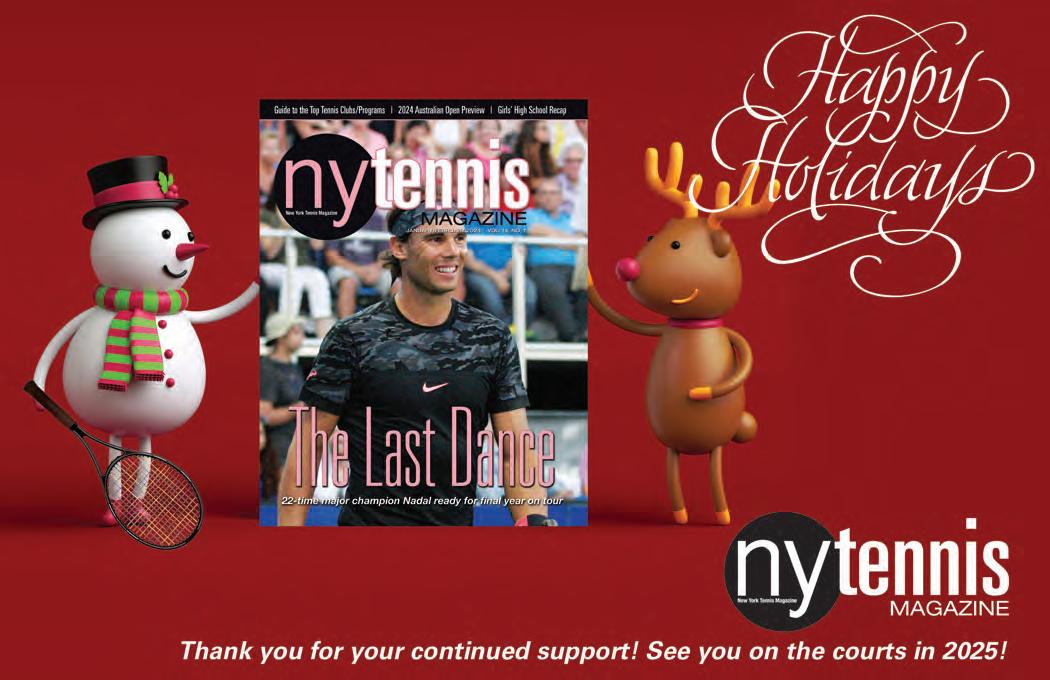


Thefourth and final Long Island Tennis Magazine Challenge of 2024 brought together men’s and women’s doubles teams for a fun and competitive Saturday hosted on the courts of Sportime Syosset.
Fresh off Thanksgiving celebrations, it was time for everyone to get back on the tennis court and work off their holiday meal, and the LITM Thanksgiving Challenge provided the perfect opportunity to do so. Featuring good competition on the court and a festive, social atmosphere off it, the Thanksgiving Challenge was the ideal way to wrap up the 2024 New York Tennis Magazine event series.
“There are many options for local players when it comes to racquet sports, and we are appreciative that so many players came out from all across the metropolitan area and chose our event. To get a sold-out draw into this tournament on a holiday weekend was a real success. I believe this is an indication that players see the professionalism and quality we bring to the events we host, and that they



have a great time on and off the court,” said David Sickmen, cotournament director of the Long Island Tennis Magazine Challenge.
In the Men’s 7.0 – 7.5 Doubles Division, Ray Omid & Ed Mulhern teamed up for the first time as a doubles pair and came away victorious by earning the title.
Despite never playing together, the two quickly found chemistry on court, and gave credit to one another for their success.
“We usually play against each
other, but came together for this,” said Mulhern. “Ray was super consistent and he hit every shot we needed him to.”
Omid added:
“Ed made it really easy…These tournaments are a lot of fun. There is always great competition, the people are chill and all of that makes these events enjoyable.”
For Jieying Mao & Anna Tortorici, the chemistry on the court together has been there for awhile now as the two have played together on USTA
Leagues teams for years. That rapport on court proved to be important as the pairing captured the title in the Women’s 7.0 – 7.5 Doubles division.
It was especially integral when they fell behind 0-2 in the championship match, before making the necessary adjustments to make the comeback and win the championship.
“In the beginning I was at the net, but I moved back to the baseline, and she went to the net whenever she had the chance so she could put it away,” said Tortorici. “We got back to our strengths. We tried to send them deep so that Jieying could poach and put it away.”
“Consistency was the key, we played our strengths to their weaknesses,” said Mao. “We play together a lot in different leagues so we know how to play together.”
The holidays are the time for families coming together, and that’s what Albert Cheng & Roger Cheng did when they joined forces in the Men’s 8.0 – 8.5 Doubles division.
The two had not played doubles together prior to this tournament which made for up-and-down results during the round-robin stages, but they found their stride in the knockout rounds, playing great tennis en route to winning the championship.
“I think when we started we were slow to get warm, but once we were able to take advantage of our service games, especially Albert because he has a really big serve, we found ways to play points a little better,” said Roger. “It was a great tournament; the competition was great, everyone was social, and it was just a really fun time especially after Thanksgiving.”
Albert talked about both the positives and negatives of playing together as a doubles team.
“This was our first time playing



together so there were definitely times we were laughing, but also times when I was like, ‘Oh, dude, you should have made that shot’,” he said. “We can call each other out when we need to, and that dynamic helps, holding each other accountable. I think we were able to step up when we needed to.”
A couple of former high school standouts took to the court in the Women’s 8.0 – 8.5 Doubles division as Onalee Batcheller & Gabrielle Vailiant paired up and ultimately
won the division’s title.
“Our groundstrokes were very good, and we poached smartly when we needed to, especially in that last match,” said Vailiant. “I felt like there were some really long rallies in the finals and so we had to be strategic with our net game.”
Batcheller added:
“We knew we could trust each other, and our communication was key. This was our first time playing doubles together but we do practice a lot, so we know each other’s styles and we

relied on each other…The tournament was great, and we were able to meet a lot of new people. Sometimes it’s easy and convenient to stay in your own little tennis group, so to play against different competition was great. Everyone was welcoming and it was very well-run.”
The Thanksgiving Challenge was the final installment of the 2024 New York Tennis Magazine Event Series, putting a bow on another successful year as we prepare to continue to grow our events in the New Year.
“I certainly want to thank our host facility, Sportime Syosset, for being such gracious hosts and Mike Kossoff for helping us put on this special event, as well as my co-director Michelle Stoerback, whose passion and energy for adult tennis is second to none,” added Sickmen. “We look forward to more community involvement moving

into the New Year. We have many events planned, and are excited to see everyone on the courts in 2025.”
Paul Stratta, CEO & Co-Founder of iPlayMe2, was on-hand to display the

results of the tournament using its innovative software so players can track their matches in real-time. For full score results visit the tournament’s brackets on the iPlayMe2 app or website.
Saturday, June 7
NYTM Summer Tennis Challenge - SPORTIME Quogue
Saturday, June 14
NYTM Summer Pickleball Challenge
SPORTIME Hempstead Lake
Saturday, September 6
NYTM Fall Tennis Challenge - SPORTIME Quogue
Saturday, September 13
NYTM Fall Pickleball Challenge
SPORTIME Hempstead Lake
There will be additional tournaments added, so be sure to visit NYTennisMag.com, e-mail info@usptennis.com or call (516) 409-4444 to learn more!






JUNIORTENNIS, JOHNMcENROE ,

JUNIOR TENNIS, TRAINING & FUN

AINING&FUN













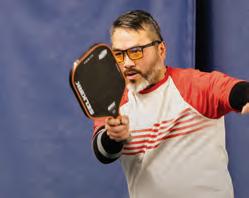









SPORTIM and great programs managem ME clubs feature more than 250 t options for learning, playing a s, private tennis and athletic tr ment, and more. Your ultimate indoor and outdoor tennis an and competing for the entire fa aining, exclusive member ben racket and paddle sports expe d pickleball courts, the best c mily, including our trademark efits, online court booking and erience is waiting for you at SP REG oaches, ked group d account PORTIME.






